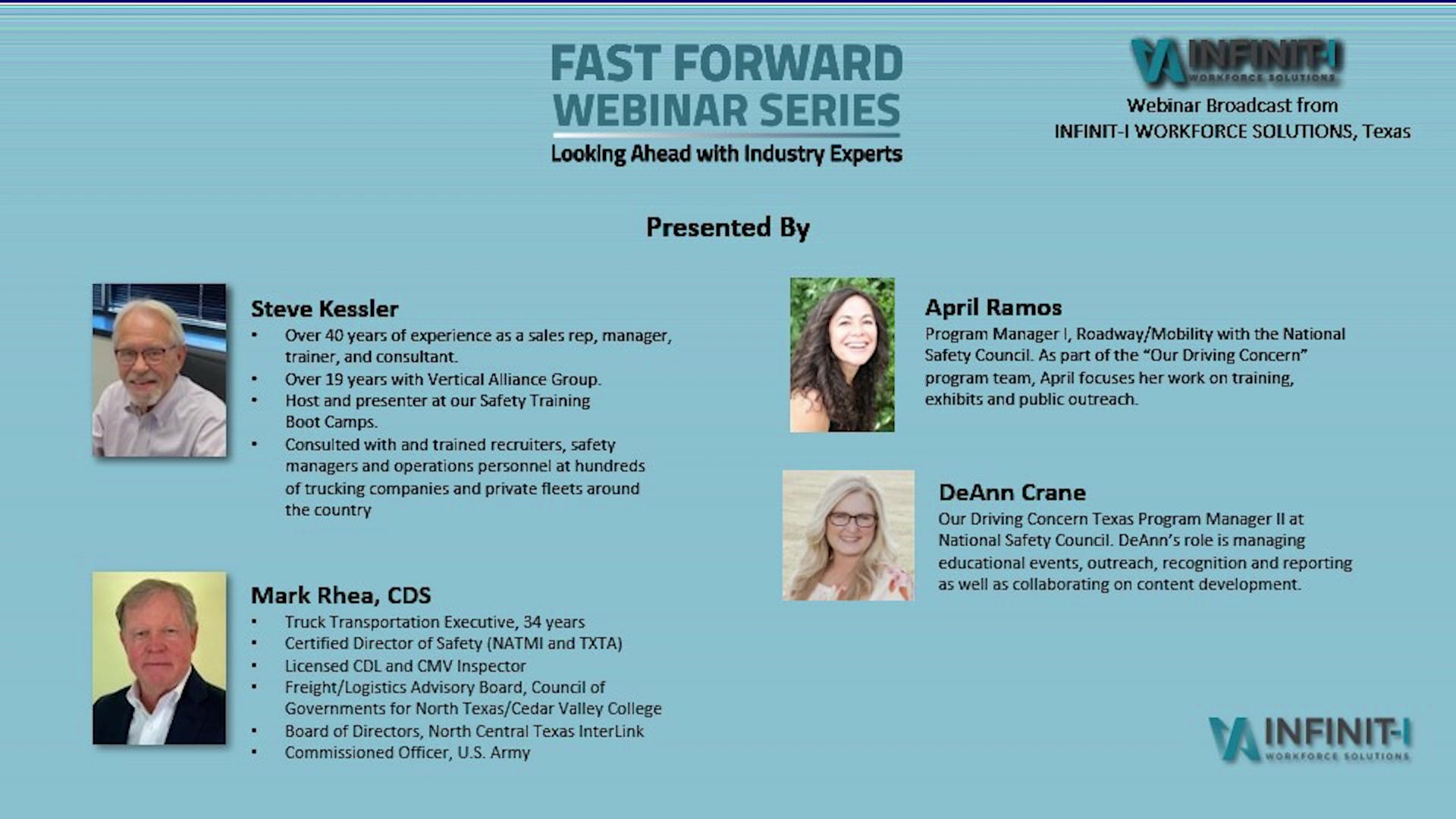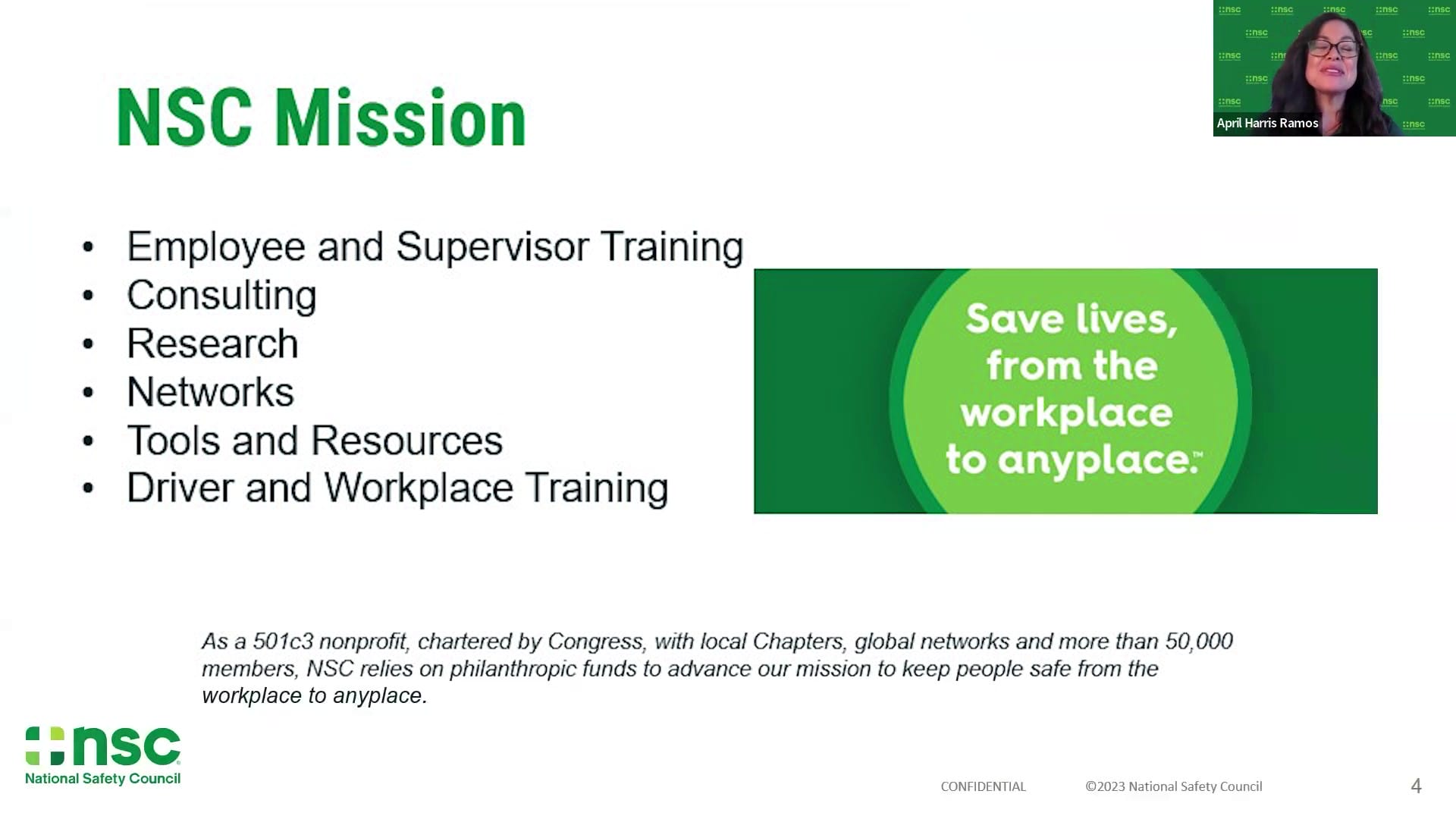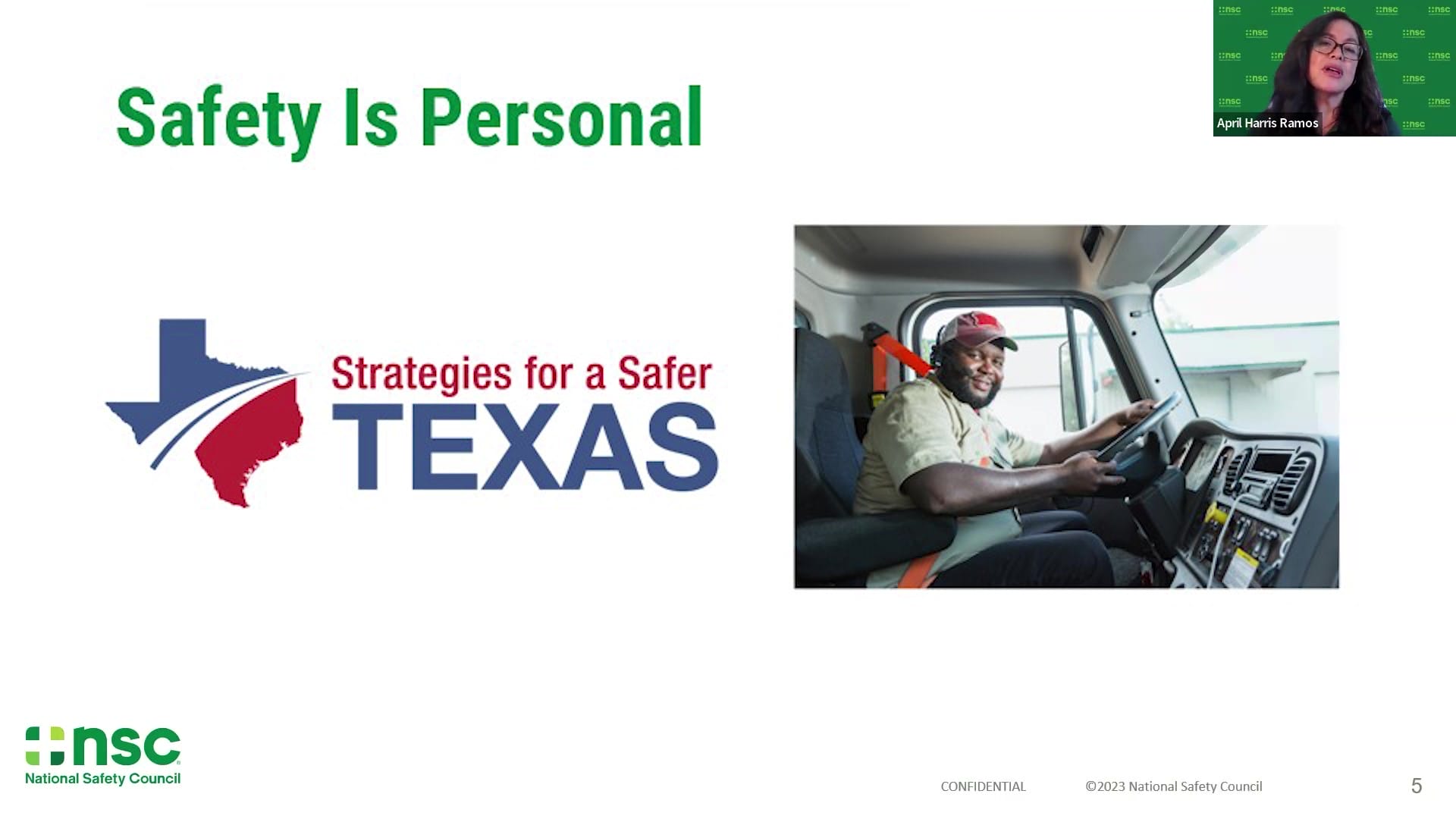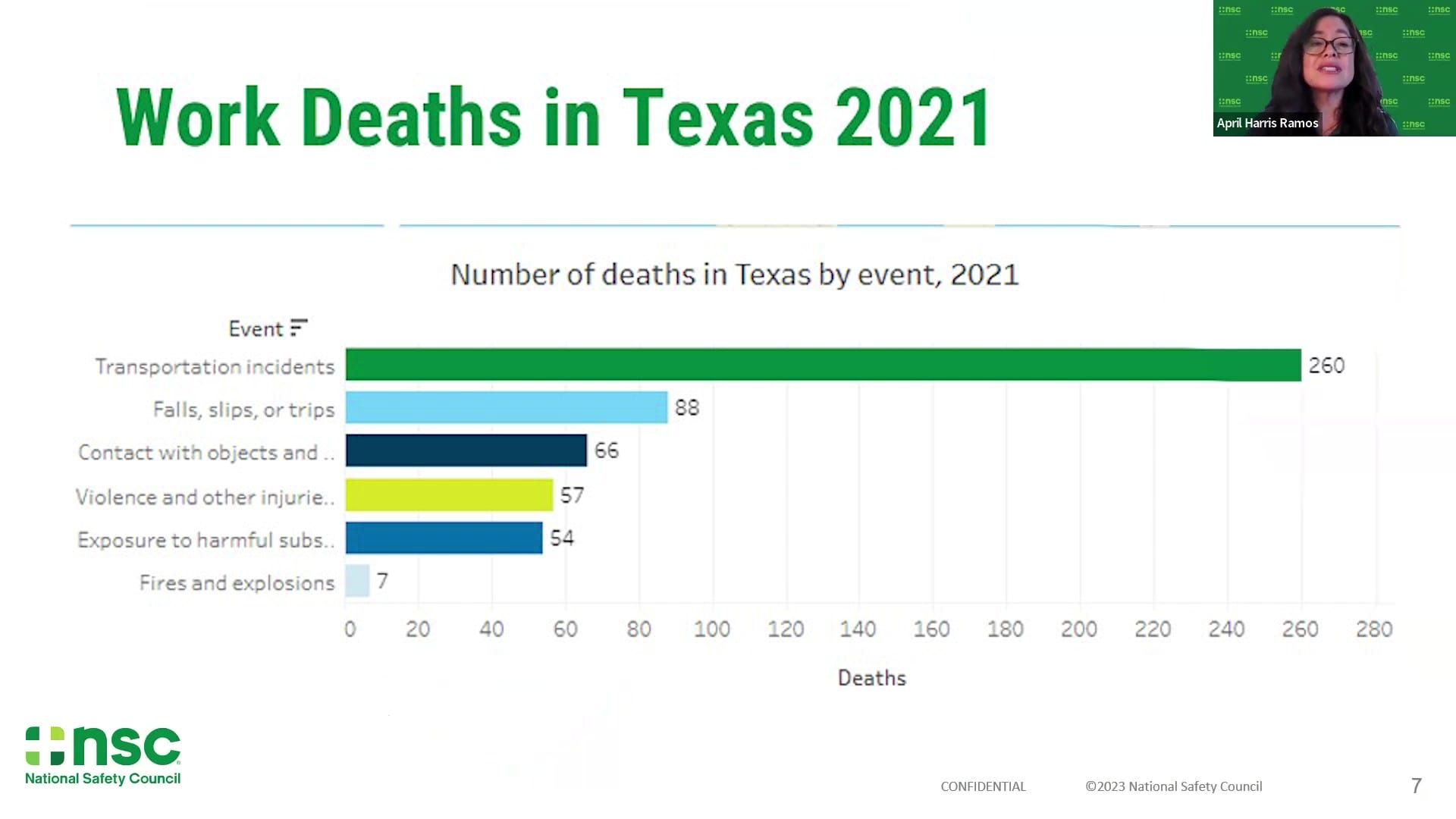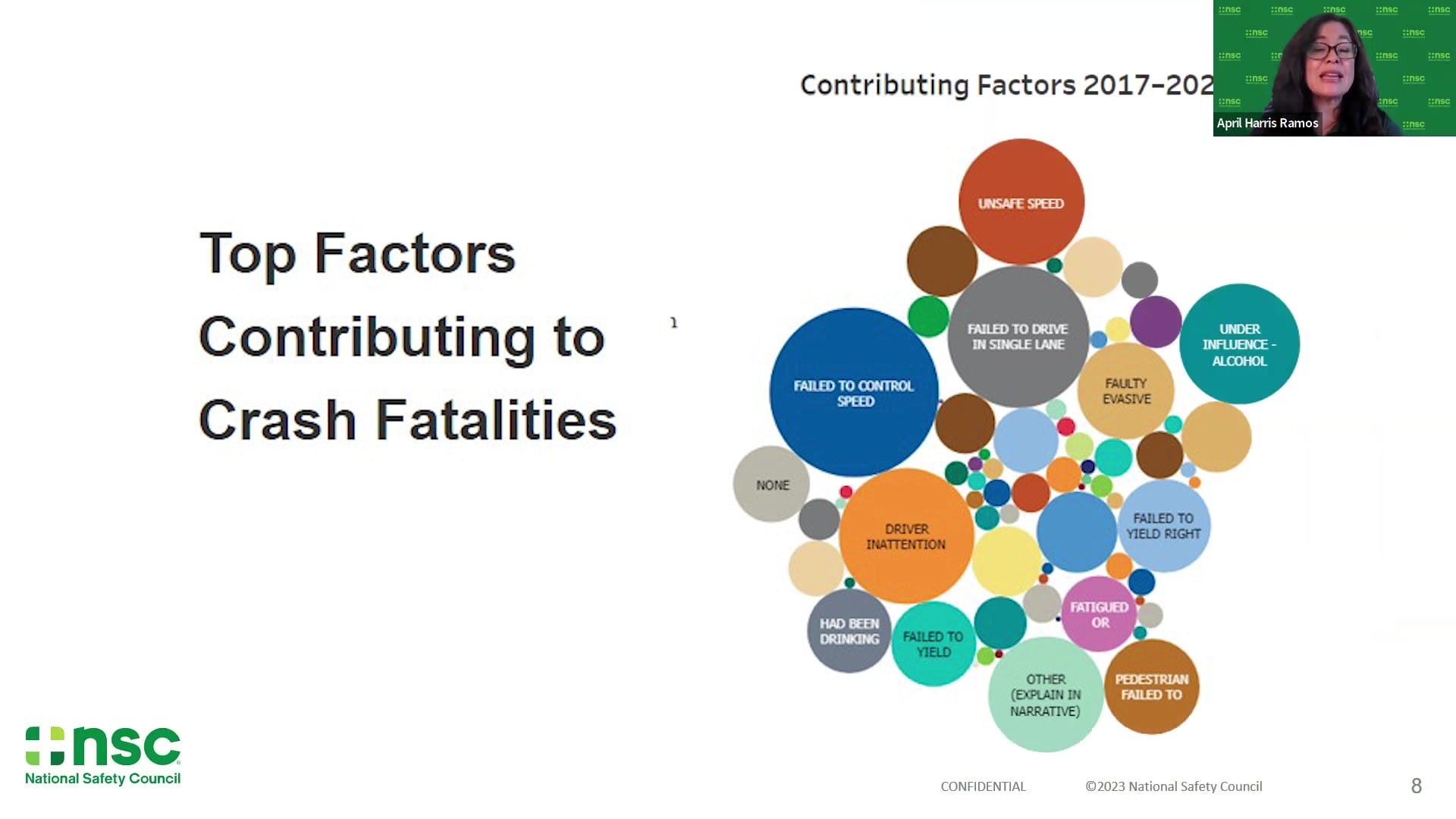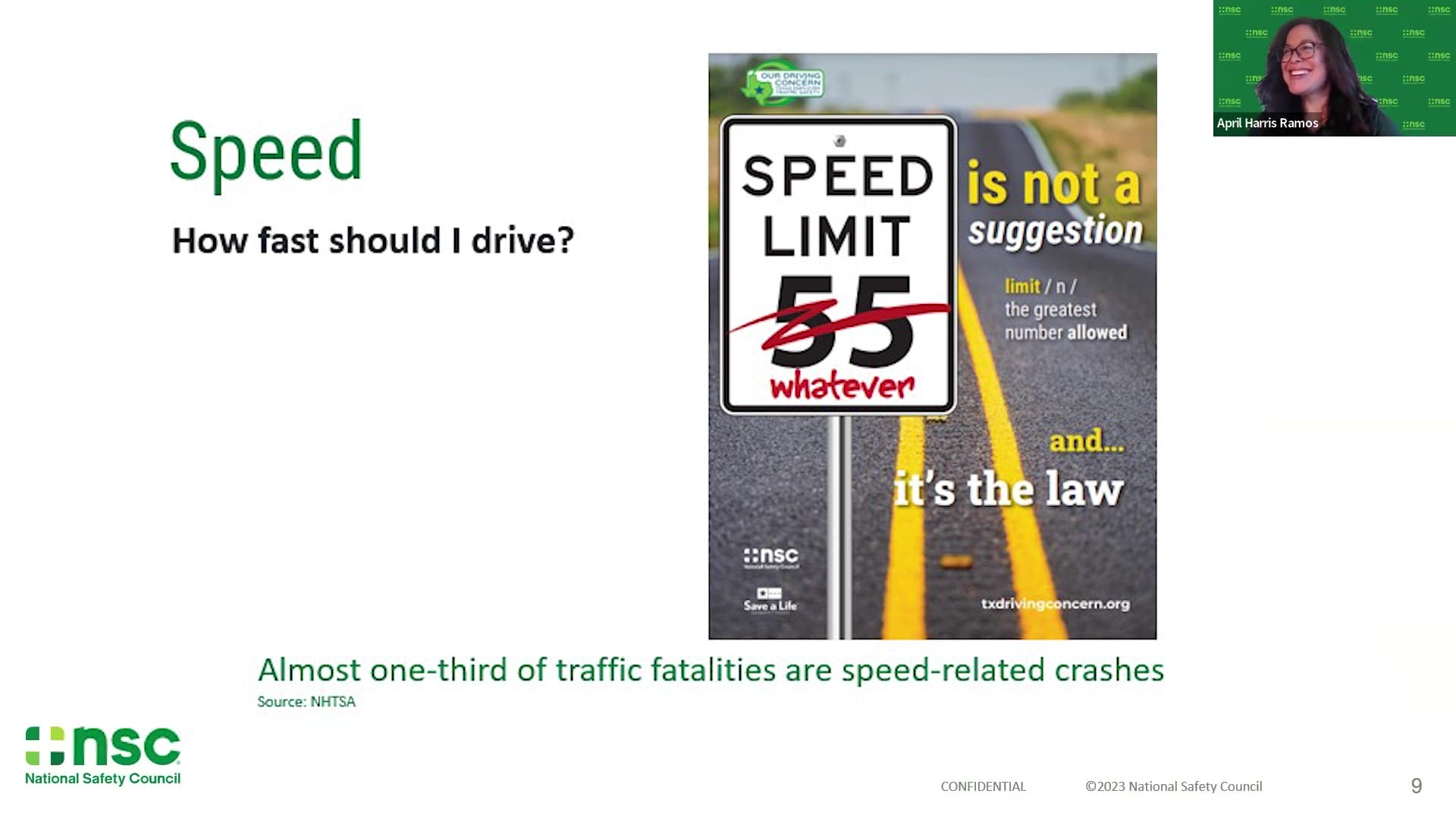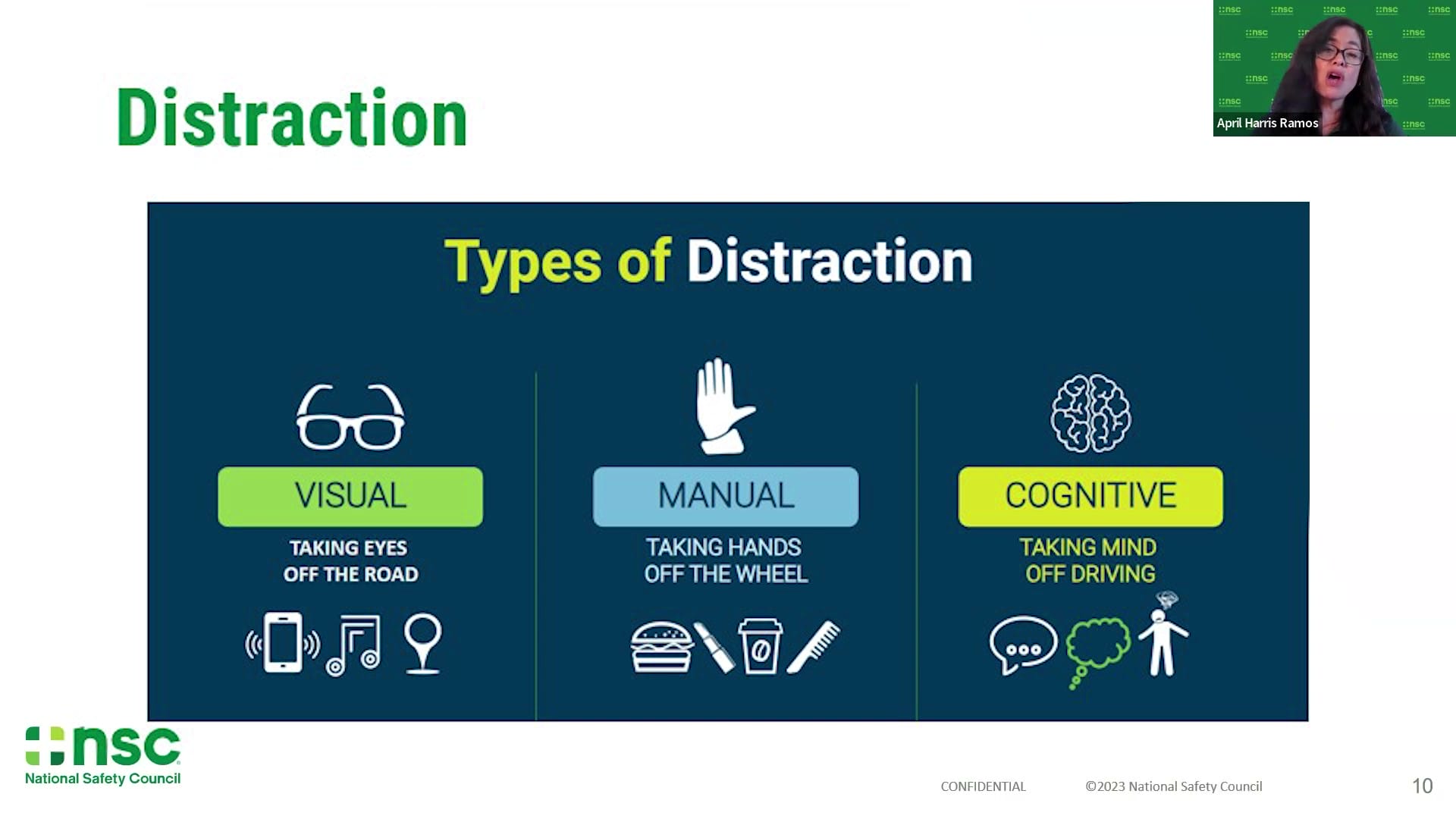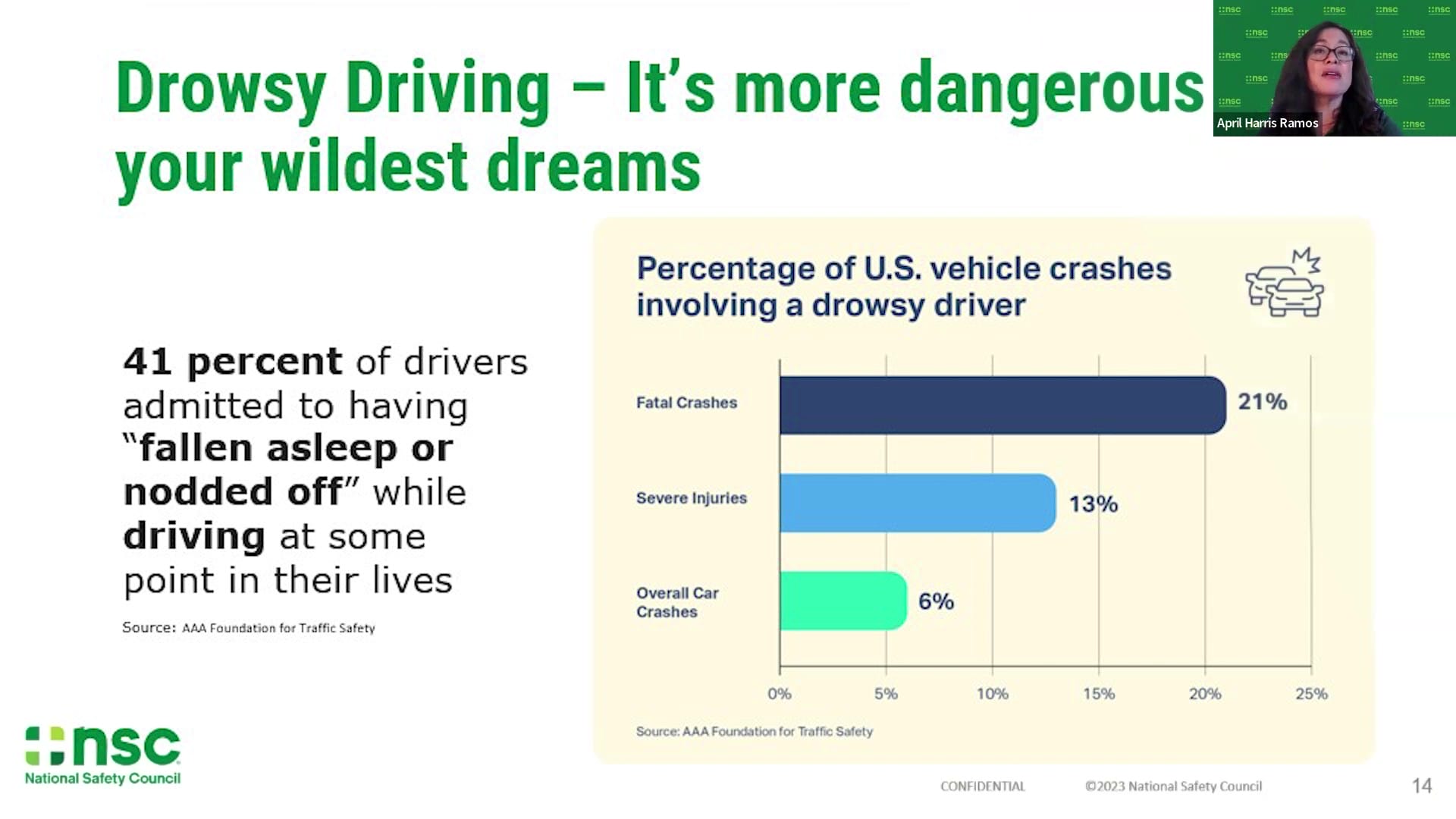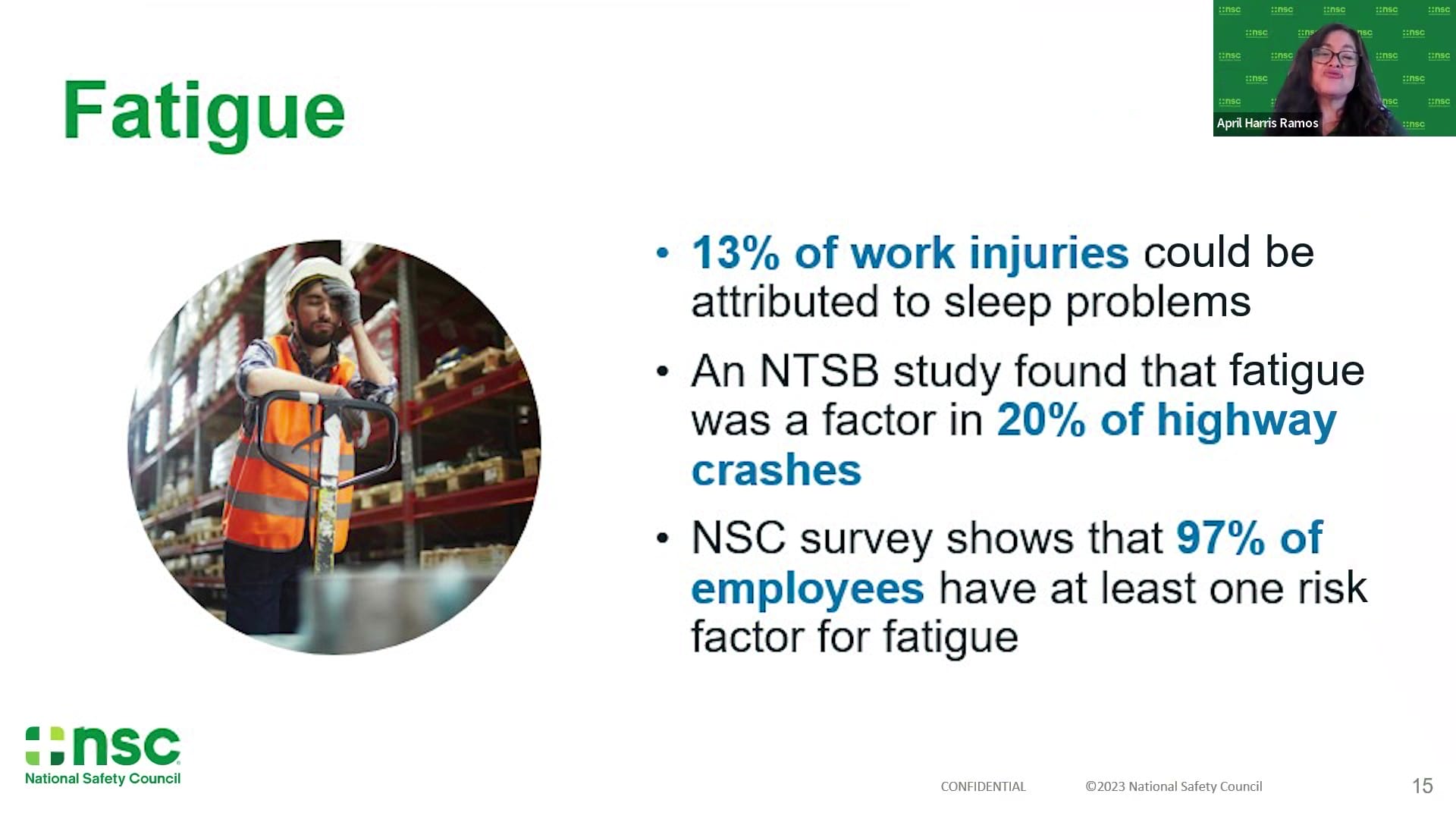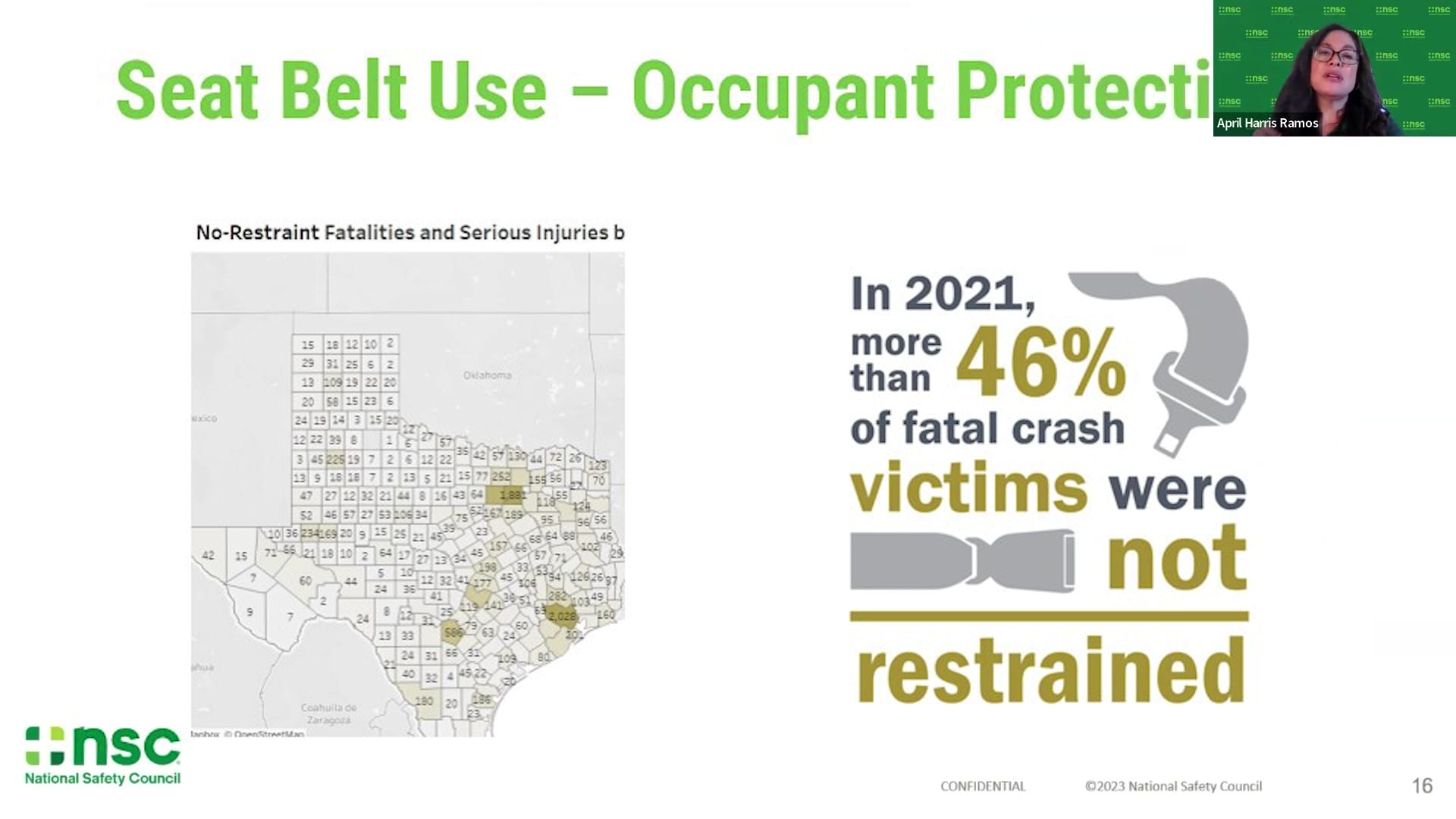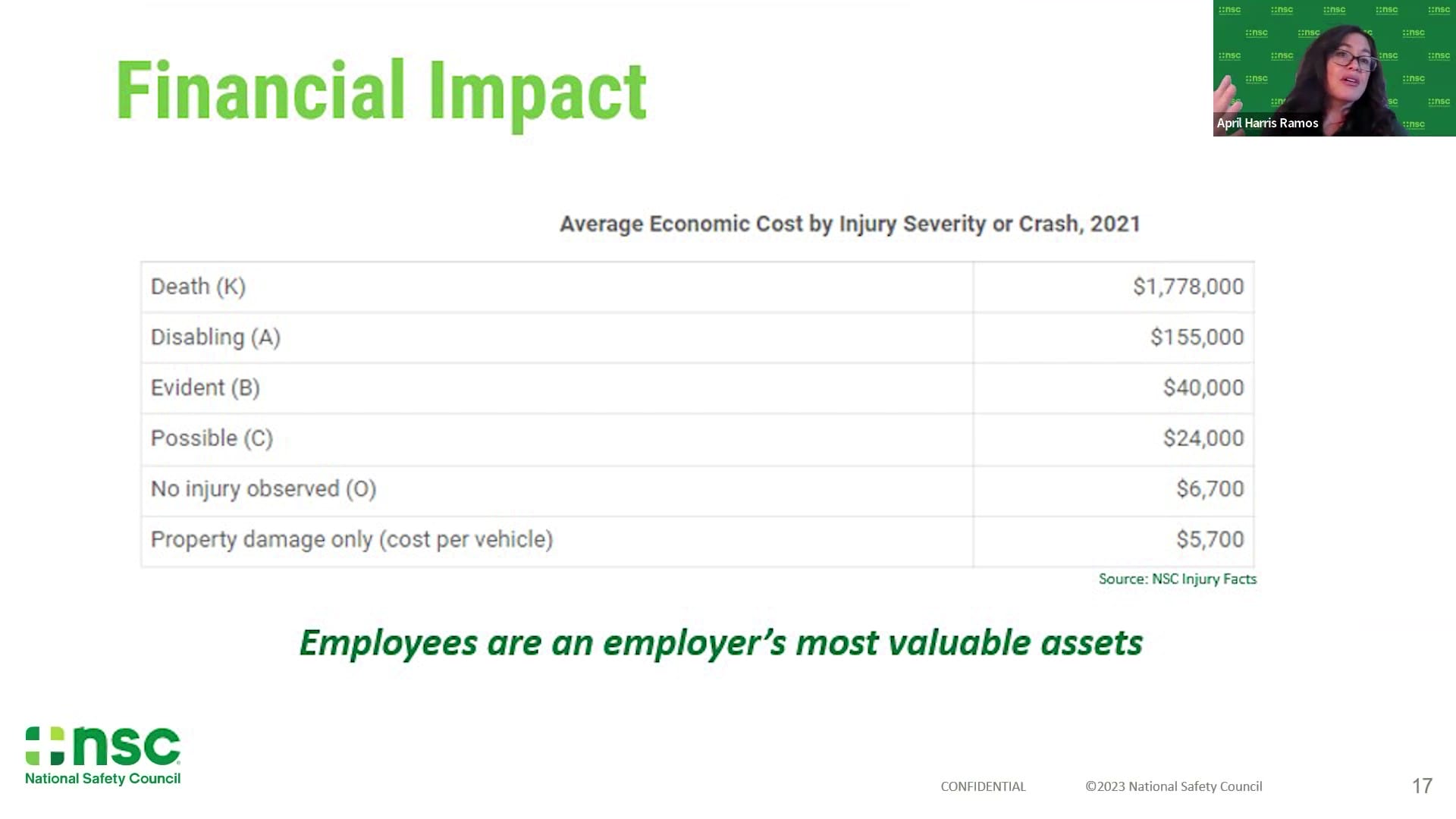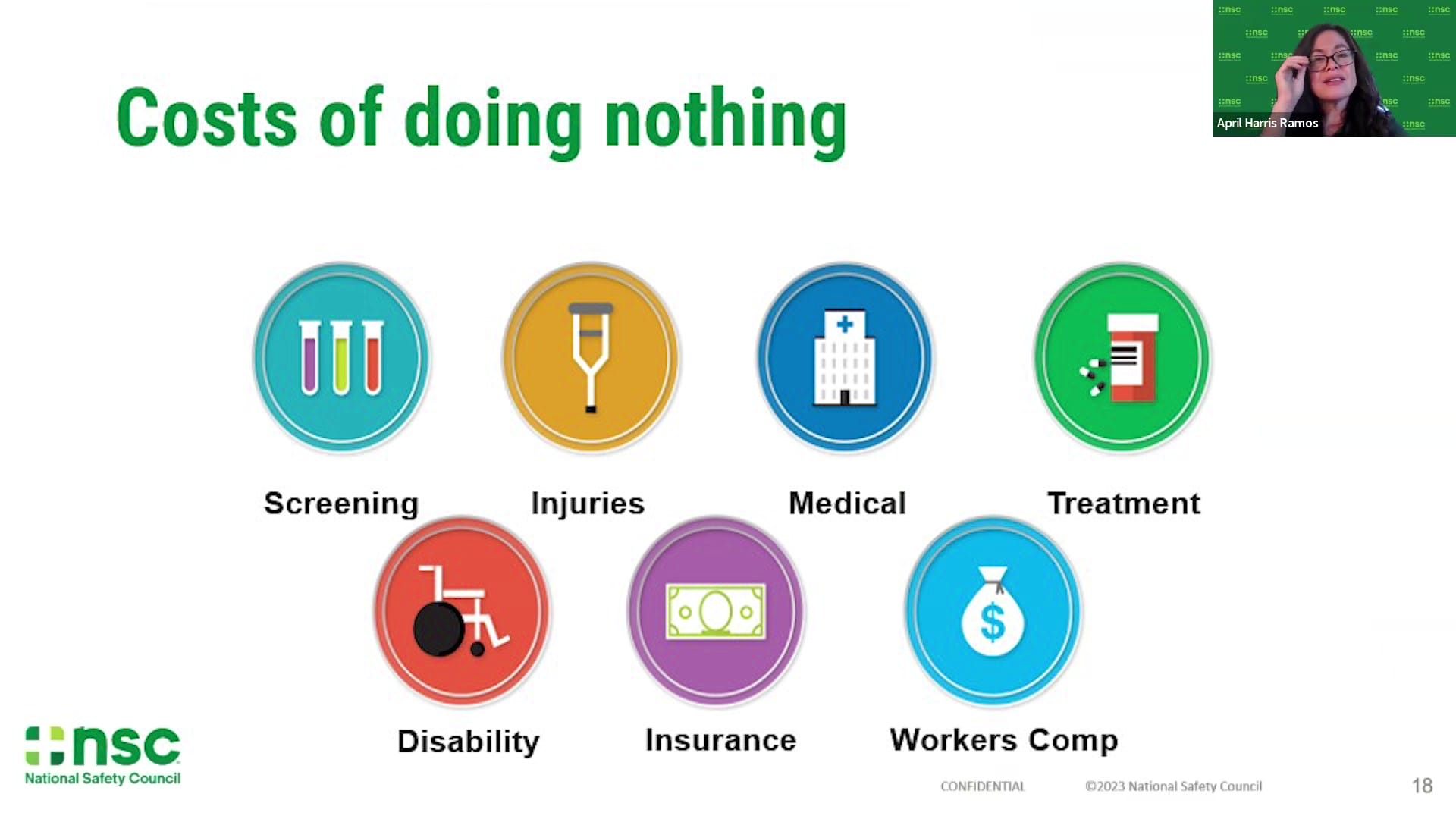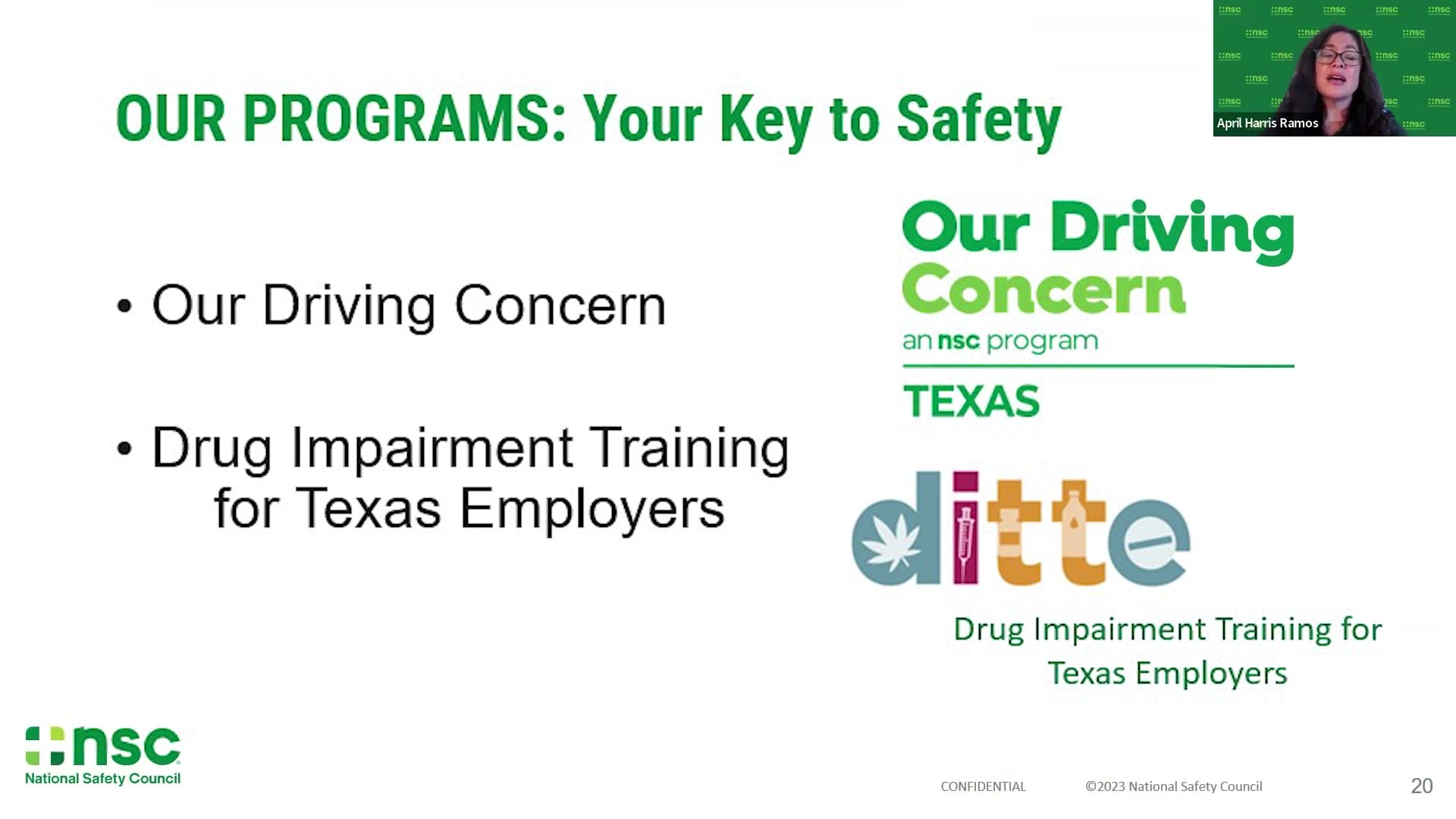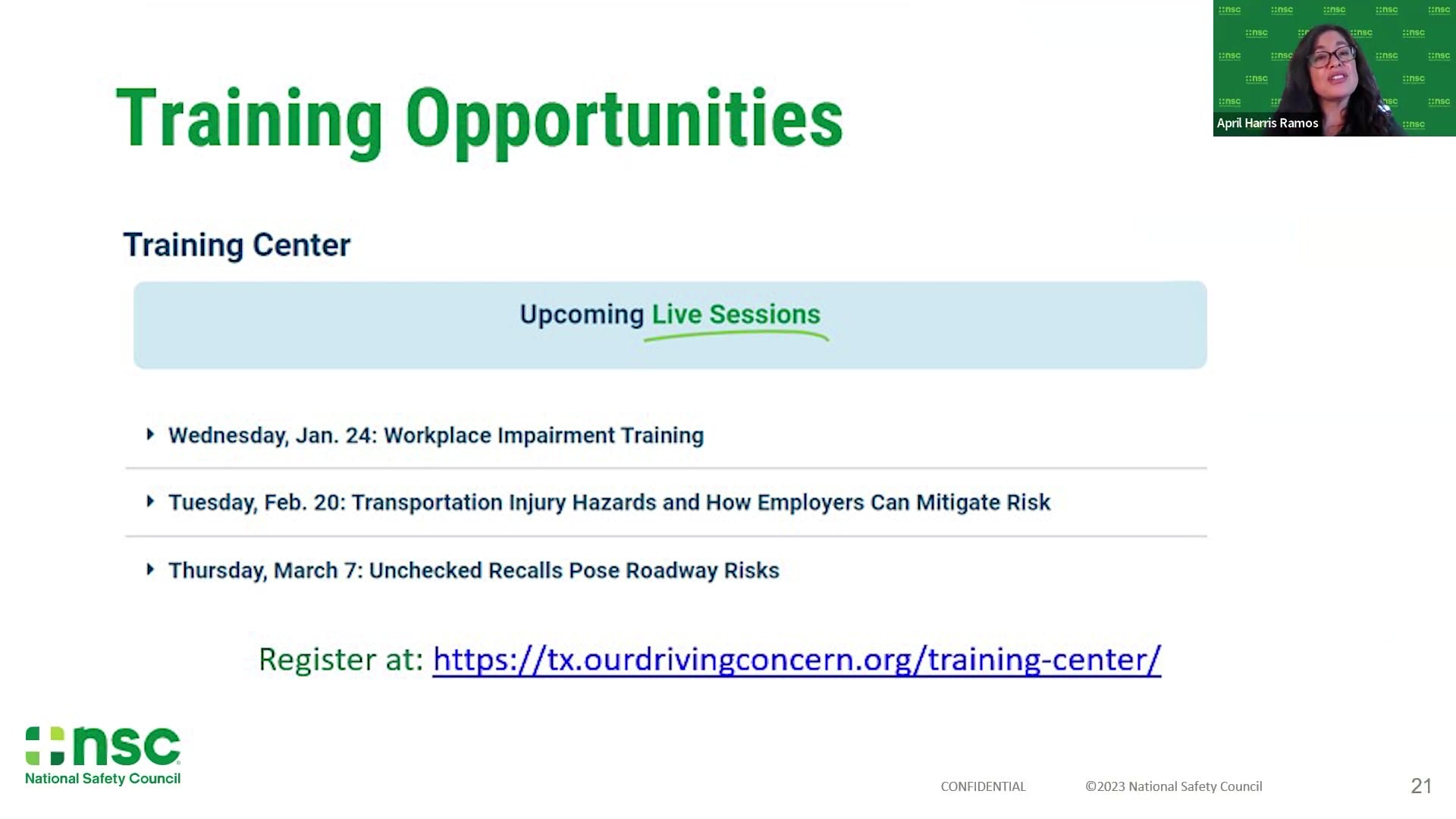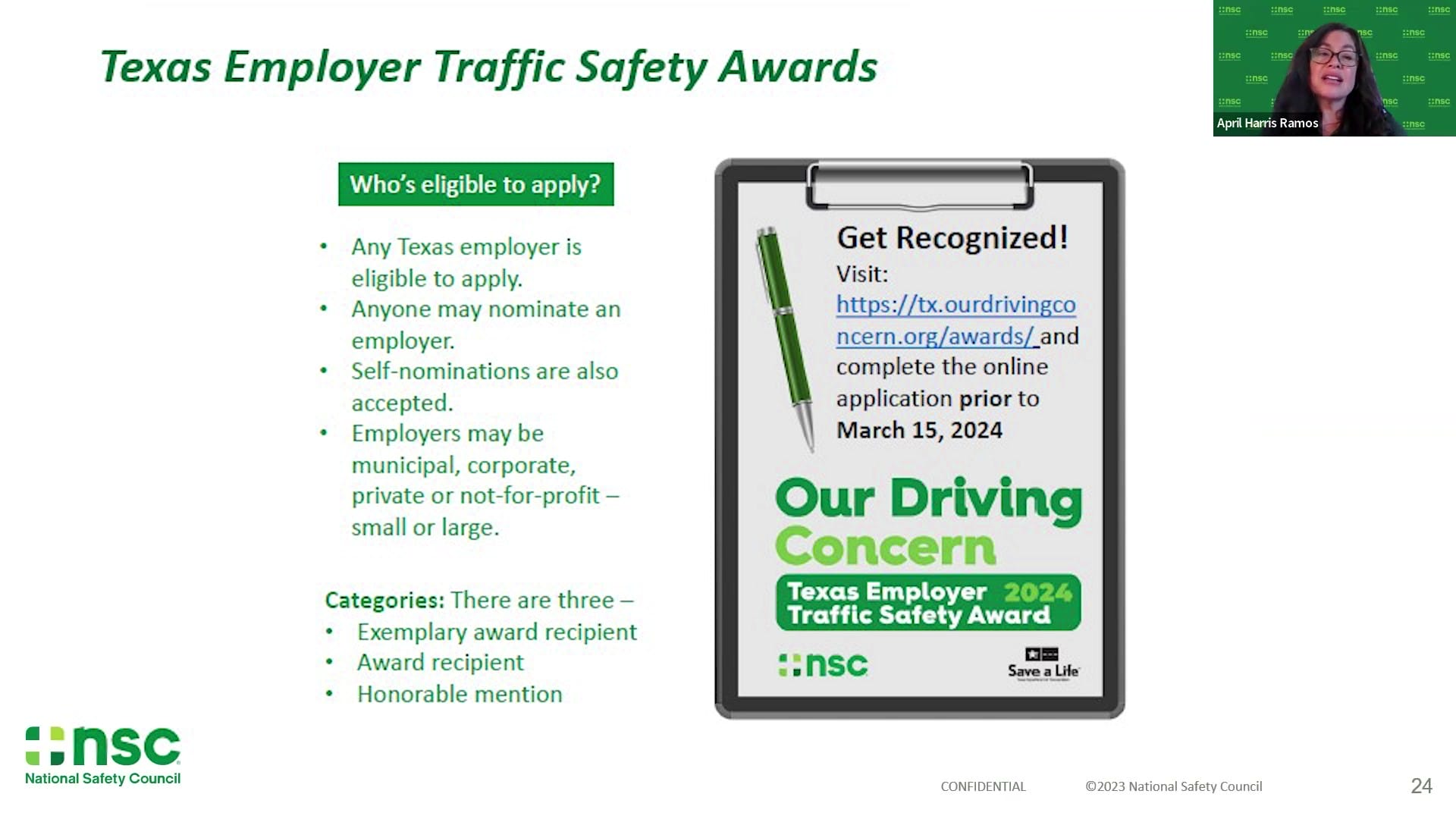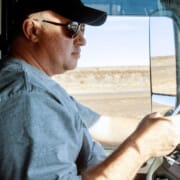Transcription
1
00:00:03.090 –> 00:00:10.880
Steve Kessler: Good afternoon, everybody. Welcome to our Infinit-I Workforce Solutions Fast forward Webinar Series.
2
00:00:11.080 –> 00:00:17.300
Steve Kessler: Very happy to have you on today. My name’s Steve Kessler and I’ll be the host of the program today.
3
00:00:17.470 –> 00:00:32.090
Steve Kessler: We’re very excited to have a couple of representatives from the National Safety Council that are going to talk with us today. And I believe we advertise this program about being about safety culture.
4
00:00:32.159 –> 00:00:42.520
Steve Kessler: And frankly, ladies and gentlemen, I don’t think I could think of a better organization than the National Safety Council to talk about Safety culture cause. That’s really
5
00:00:42.600 –> 00:01:06.579
Steve Kessler: pretty much what their mission is. I believe I’m correct in saying that. So, we’re very excited to hear what they have to say. And I also wanted to introduce you all to Mark Rhea. Mark’s been a co-host with us here on a lot of our webinars. Mark’s an industry veteran who has been an executive in the trucking industry for many years.
6
00:01:06.610 –> 00:01:29.580
Mark Rhea: I believe, Mark, if I’m not mistaken, you’ve done some work with the National Safety Council in some ways. That right? Absolutely. Yes, I’ve used their commercial truck defensive driving. I think it’s called the professional truck driving program in Lu, in combination with several insurance companies to help a lot of companies with.
7
00:01:29.620 –> 00:01:44.930
Mark Rhea: You know, some drivers that that need some corrective action. And Deanna, I was going to be our driving concern, which is a fantastic program that’s really designed. I’ll let her do all the talking, you know. I hear all the time.
8
00:01:45.040 –> 00:01:46.040
Mark Rhea: You know.
9
00:01:46.350 –> 00:01:54.589
Mark Rhea: we, our commercial trucks aren’t in the wrong. It’s all those other cars. It’s everybody else, and
10
00:01:54.760 –> 00:02:02.910
our driving concern has listened to those comments from our industry and our drivers, and has a program designed to help
11
00:02:03.110 –> 00:02:14.890
Mark Rhea: share that information and educate the rest of the motoring public on commercial trucks out there trying to operate. So, it’s going to be a great afternoon. I’m really looking forward to this.
12
00:02:15.600 –> 00:02:42.970
Steve Kessler: Very good thanks, Mark. Well, let’s move right on in. I know a lot of folks are joining the meeting. If you all don’t mind out there if you jump on the chat and just let us know who you are and who you work with, and maybe where you’re joining us from. We’d love to know who’s on here with us today. And while you all are doing that, let me introduce our guest today. First, we have. April Ramos
13
00:02:43.050 –> 00:02:56.079
Steve Kessler: April is a program manager, I think, with what they call roadway mobility with the National Safety Council, and as part of our driving concern that Mark talked about.
14
00:02:56.080 –> 00:03:16.630
Steve Kessler: April focuses a lot of her work on training and exhibits and public outreach. So, we’re very glad to have April here also, joining us from the National Safety Council is Dean Crane. Dean is our driving concern. Texas program manager at the National Safety Council, and her role
15
00:03:16.630 –> 00:03:42.949
Steve Kessler: is managing educational events, outreach recognition and reporting, as well as collaborating on content and other development. So, we’re very, very happy to have these 2 ladies join us today and without any further delay. let’s in charge, I think April, you’re going to kick it off, so we’ll let April. Take off on the program. Go ahead. April.
16
00:03:43.110 –> 00:04:07.750
April Harris Ramos: Hi, thank you so much, Steve. Very happy to be here. Yes, I am with the employer. Traffic safety program, our driving concern for the State of Texas and yes, NSC does eat breath and sleep, safety. With that, let me tell you a little bit about our mission. Our mission is to save lives from the workplace
17
00:04:07.750 –> 00:04:30.709
April Harris Ramos: to any place we do that through employee, and it’s a supervisor training which you might be familiar with, especially our defensive driving program. Consulting research. We have networks. We have more than 50,000 members at 50, at 15,000, Us works. So, it is a really big network of safety professionals and organizations.
18
00:04:30.800 –> 00:04:44.439
April Harris Ramos: we have a ton of tools and resources. We’re going to talk to you about some of those things and our driver and workplace training. So that’s how we work on our mission of saving lives from the workplace to any place.
19
00:04:45.650 –> 00:05:06.100
April Harris Ramos: but just a reminder. As we start talking about safety and safety culture, that safety is personal. So, if you’re not making safety personal at your work site. That could be the piece that’s missing. This picture of this driver. He’s got a family and he’s got loved ones. So
20
00:05:06.320 –> 00:05:15.350
April Harris Ramos: it’s not just on his job that he’s driving. He’s driving off the job, too. You guys may have kids or a partner or spouse
21
00:05:15.370 –> 00:05:31.470
April Harris Ramos: parents. Right, I have 2 teenage boys that drive with me all the time. Ride with me. And so, it is the top of my list of safety concerns for my children is driving. It’s the most dangerous thing that they do
22
00:05:31.470 –> 00:05:46.599
April Harris Ramos: is ride as a passenger in a vehicle. You know. They walk to school. They brush their teeth. None of those things. No one ever died from not brushing their teeth. But you can get injured or die from riding in a motor vehicle. So
23
00:05:46.610 –> 00:05:48.489
April Harris Ramos: let’s jump right on in
24
00:05:48.560 –> 00:06:00.769
April Harris Ramos: it shouldn’t come as a surprise. The leading cause of preventable injury related death by State. So, 20 States motor vehicle crashes were the number 2 cause of death.
25
00:06:00.960 –> 00:06:02.410
April Harris Ramos: But for Texas
26
00:06:02.630 –> 00:06:21.640
April Harris Ramos: work related deaths. So, we’re getting specific now, work deaths in Texas for that same year you can see that transportation incidents lead the pack right of over everything else, like falls or exposure to harmful chemicals or substances. It is those transportation incidents.
27
00:06:22.360 –> 00:06:41.659
April Harris Ramos: So, what do you think are the top contributing factors to crash fatalities? So, what of all the things that cause car crashes right? Are the top reasons that people die in those car crashes. Type it into the chat. What do you think it is. I’m pretty sure you’re going to get it all right.
28
00:06:42.810 –> 00:06:49.340
April Harris Ramos: I’ll give you a moment. Check out that. See if I can see the chat distracted driving cell phones.
29
00:06:49.750 –> 00:06:53.050
April Harris Ramos: distracted driving cell phone distractions. Yes.
30
00:06:53.190 –> 00:06:59.100
Mark Rhea: yes, yes, yes, absolutely. You guys know what the problem is. Right? We know what the problems are.
31
00:07:00.560 –> 00:07:06.419
April Harris Ramos: So, as you can see from this slide the contributing factors, the number one is speeding
32
00:07:06.870 –> 00:07:10.189
April Harris Ramos: a driver, inattention, or distraction, as many of you said.
33
00:07:10.380 –> 00:07:24.759
April Harris Ramos: failure to drive in a single lane. That’s specific. But that often happens because of speeding. Or you’re inattention, right? When you see someone on their phone, what do they do? They kind of drift right one way or the other, or maybe even both
34
00:07:25.090 –> 00:07:49.960
April Harris Ramos: unsafe speed for the conditions. This is critical in Texas, because we don’t like driving on anything other than dry, perfectly clear days, right? And so, we need to adjust our speeds. When it those conditions. Call for it right? And then number 5 driving under the influence and not just alcohol. But it could be drugs or some other substance.
35
00:07:50.990 –> 00:07:54.379
April Harris Ramos: But let’s talk a moment about speed. Okay.
36
00:07:54.510 –> 00:07:57.130
April Harris Ramos: how fast should you drive?
37
00:07:58.480 –> 00:08:01.929
April Harris Ramos: Is the are the signs a suggestion?
38
00:08:02.700 –> 00:08:06.050
April Harris Ramos: I’m going to check out your chat.
39
00:08:08.980 –> 00:08:10.869
Steve Kessler: Yeah, we’re seeing this
40
00:08:11.200 –> 00:08:18.230
Steve Kessler: black screen again. I’m not sure in the middle, but I think it might be your chat box.
41
00:08:18.460 –> 00:08:20.170
April Harris Ramos: Oh. about that.
42
00:08:21.390 –> 00:08:32.400
DeAnn Crane: There you go! You’re a genius, Dan. One problem. I’ll check out the chat.
43
00:08:32.450 –> 00:08:39.040
April Harris Ramos: Thank you. That would be lovely not to speed. How fast should you drive?
44
00:08:40.490 –> 00:08:44.470
April Harris Ramos: And I’ll let Dean read out some of your comments in the chat.
45
00:08:44.580 –> 00:08:52.770
DeAnn Crane: We’re hearing. Some recommended the recommended speed. As the conditions require you to safely travel
46
00:08:54.100 –> 00:08:59.729
maximum recommended the 2 conditions, the speed limit.
47
00:09:00.450 –> 00:09:22.710
April Harris Ramos: So, a lot of a lot of the same things, right speed for the right conditions, absolutely. And so, the posted speed limit is the law. But the law also states that you need to adjust that speed according to the conditions. And the reason that speed is such a problem, right? Is because when you’re going over that posted speed limit.
48
00:09:22.710 –> 00:09:33.709
April Harris Ramos: the limit at which people have determined engineers is a safe speed for that road. So, the width of the road. How many lanes there are?
49
00:09:33.710 –> 00:09:47.560
April Harris Ramos: The degree like how level what your line of sight is? They’ve taken a lot of things into consideration to set a posted speed limit. So, I’ll give you an opposite example. If you’ve ever driven out to El Paso.
50
00:09:47.620 –> 00:09:51.130
April Harris Ramos: What’s the speed limit out there. What does that road look like?
51
00:09:52.330 –> 00:10:12.570
April Harris Ramos: The speed limits? Really high, isn’t it? I think it’s 80. Please feel free to correct me. But I say it’s 80 and you can see 4 miles at some points, right? And the side of the road. There’s nothing out there. It’s not like a cars going to come darting out from the side cause there’s no road there. So
52
00:10:12.840 –> 00:10:28.550
April Harris Ramos: That’s the reason, or some of the reasons, anyway, that they have higher speed limits out there, because the conditions and the road allow it right. But think about that 30 or 35 mile per hour speed limit in a neighborhood or residential area. Right?
53
00:10:28.900 –> 00:10:37.070
April Harris Ramos: It’s low. For a reason kids could come darting out. People could back out. There are so many reasons to adjust your speed and go slower.
54
00:10:38.100 –> 00:10:50.290
April Harris Ramos: Next on that list of factors for fatalities was distraction. So, types of distraction. You may have seen this before visual manual, cognitive
55
00:10:50.290 –> 00:11:12.919
April Harris Ramos: so that visual distraction obviously taking your eyes off the road. Manual, taking your hands off the wheel and cognitive, taking your mind off driving and it could be. You know that you’re lost in your thoughts. But it could also be that you have a lot of stress right on the job or at home. And that is, you know, occupying your thoughts and distracting you from driving.
56
00:11:14.440 –> 00:11:15.480
April Harris Ramos: So
57
00:11:16.240 –> 00:11:25.500
April Harris Ramos: this picture is on here with the football field and the 55 mile per hour. sign, just so that you understand that
58
00:11:25.900 –> 00:11:28.269
April Harris Ramos: 5 s.
59
00:11:29.490 –> 00:11:37.560
April Harris Ramos: oh, no! When you’re traveling feet per second, or your car is traveling in feet per second, right? And so
60
00:11:37.890 –> 00:11:50.989
April Harris Ramos: one and one-half times your speed. So, at 70 miles per hour, that’s 105 feet per second. So just think about that for a second. If you’re traveling 70 miles per hour, you’re going 105 feet per second.
61
00:11:51.370 –> 00:11:56.229
April Harris Ramos: that’s one third the length of a football field in just 1 s.
62
00:11:56.450 –> 00:12:10.550
April Harris Ramos: So, bringing you this information to help you kind of reframe the way you think about it, because oftentimes we’ll hear from drivers whether they’re commercial motor vehicle drivers or just regular drivers, you know. I will look down for a second
63
00:12:10.550 –> 00:12:27.380
April Harris Ramos: whether it was on their phone or to get something. Well, when you’re traveling at a higher rate of speed even at a low rate of speed, it makes a difference. You’re traveling much faster. You’re covering more ground than you realize. Right? We just kind of get desensitized to it after a while because we do it all the time.
64
00:12:27.380 –> 00:12:37.730
April Harris Ramos: maybe without incident, right? So just something to think about when we hear that excuse of it was just a quick call. It was just a short trip, or whatever
65
00:12:38.950 –> 00:12:49.459
April Harris Ramos: number 5 on that list earlier was impaired driving. So, alcohol impaired, driving killed 963 people in Texas in 2021.
66
00:12:49.670 –> 00:13:12.449
April Harris Ramos: That’s a lot of people, right? Even one is a lot. But this is a lot of people. As we posted the law up here, and I just want to give you a reminder that the Bac to point O. 8. That’s just the measurement at which you will get a citation. A person can be impaired before that. And, in fact, at NSC. We like to remind people that impairment starts with the first drink
67
00:13:12.480 –> 00:13:22.629
April Harris Ramos: or the first ingestion of whatever substance that you’re taking, impairment begins. So important. Just again, we’re trying to reframe this, try to re
68
00:13:22.680 –> 00:13:28.309
April Harris Ramos: think the way that we our attitudes and beliefs about all these topics.
69
00:13:28.370 –> 00:13:56.389
April Harris Ramos: And so, before I get into the next slide which talks about a workplace impairment survey that we conducted. I just want to ask the group what your attitudes and beliefs about the topics are that we’ve just covered, such as distracted driving, impaired driving, speeding, because they are a big part of culture. The biggest part of safety culture is your attitude and belief. So not just you know, we’re meeting the requirements
70
00:13:56.390 –> 00:14:12.870
April Harris Ramos: of our organization or the Federal Government. But what do you believe about? Are you following the requirement? Because you believe it’s good for yourself, for your employees, for your business? Or are you just trying to meet the minimum? Right? So, what are your attitudes and beliefs?
71
00:14:13.570 –> 00:14:20.349
April Harris Ramos: Could you use a refresher? Could you use a little. you know invigoration of your attitudes and beliefs.
72
00:14:20.710 –> 00:14:24.079
April Harris Ramos: and do you share those with your employees?
73
00:14:25.240 –> 00:14:27.250
April Harris Ramos: So, give you a minute to type in the chat.
74
00:14:27.740 –> 00:14:39.860
April Harris Ramos: I know, that’s kind of a big question, but it’s an important one. So, take a minute to think about it. If you need to. And definitely at the end we’ll leave some time for discussion cause? I think that’s
75
00:14:39.980 –> 00:14:41.520
April Harris Ramos: so important.
76
00:14:41.840 –> 00:14:54.379
DeAnn Crane: Well, it’s great. Because we did have someone already typing the chat a great response. And it is because we all want to get home at night. So I think that is a great response.
77
00:14:54.710 –> 00:15:00.489
April Harris Ramos: Yeah, absolutely. That’s a that’s a fantastic response. I think the same thing. Every time
78
00:15:00.640 –> 00:15:12.279
April Harris Ramos: I’m out driving I need to get home to my boys. I’m very specific. I want to get home to my boys; I want to give it to my kiddos. So yeah, whatever it takes, right, whatever it takes to get there safely.
79
00:15:12.910 –> 00:15:14.600
April Harris Ramos: Anything else, Dean.
80
00:15:17.590 –> 00:15:27.569
DeAnn Crane: we have had A few responds that their expectation of themselves is what they expect of others. So, they
81
00:15:27.660 –> 00:15:29.410
DeAnn Crane: I walk the talk.
82
00:15:29.980 –> 00:15:34.990
April Harris Ramos: Good. That’s awesome. I am really, you know, a big believer in that
83
00:15:35.240 –> 00:15:39.300
April Harris Ramos: saying do what I do right
84
00:15:39.570 –> 00:15:48.410
April Harris Ramos: sometimes it’s the reverse. Do what I say, not what I do, and I think, as safety leaders or just leaders in general. It’s so important
85
00:15:48.460 –> 00:15:55.160
April Harris Ramos: to have your actions speak louder than your words. Right? It’s important to say it, obviously. But
86
00:15:55.660 –> 00:16:01.349
April Harris Ramos: people will listen to what you say. But then they watch what you do so important that those
87
00:16:01.630 –> 00:16:12.779
April Harris Ramos: match up right that those align well, let’s get moving and feel free to keep typing in the chat if you were. But I want to tell you about a an NSC employer survey that we conducted in 2020.
88
00:16:13.150 –> 00:16:40.290
April Harris Ramos: I don’t know why we did this during the pandemic, but we did to understand how employers view impairment as a safety risk and what they’re doing to address it. And here are the results. A little over half of the respondents stated that impairment is decreasing the safety of their workplace. So, it’s on their radar. They can see that it’s a problem. 45% say impairment is causing more near misses.
89
00:16:40.470 –> 00:16:46.990
April Harris Ramos: And then, lastly, that 39% say impairment is causing more injuries. So
90
00:16:48.270 –> 00:17:05.140
April Harris Ramos: what are they? I’m interested. I wish I had the rest of that survey to know what they did about it. But we’re going to get some give you guys some ideas. So, most people know, I think, what the survey says is that employers know it’s an issue, right? They know impairment is an issue.
91
00:17:05.440 –> 00:17:14.740
April Harris Ramos: and one of those things that could be impairing is drowsy driving, and I don’t think we give this enough attention. I am, you know.
92
00:17:14.859 –> 00:17:35.969
April Harris Ramos: was raised by old school parents and grandparents that really believed in like you just suck it up right. You’re tired. Will you give me more sleep tomorrow? And if you don’t get more sleep tomorrow, you could make up for it on the weekends. Well, you know, as a student, me being sleep impaired. Wasn’t as critical as someone who’s driving
93
00:17:35.970 –> 00:17:46.690
April Harris Ramos: a semi-truck for a living right or another safety, sensitive position like I don’t know your doctor, or you know your airplane pilot. Those are safety sensitive jobs.
94
00:17:46.690 –> 00:18:03.400
April Harris Ramos: Even someone preparing your food right. You want them to be alert and do their job thoroughly and efficiently. So, you can see 41% of drivers admitted to having fallen asleep or nodded off at driving at some point in their lives.
95
00:18:03.590 –> 00:18:11.429
April Harris Ramos: I’m curious if any of you guys want to admit that’s ever happened to you. But does that statistic seem? Is that surprising to you? Does that seem
96
00:18:11.510 –> 00:18:21.209
April Harris Ramos: like it’s true that 41% so getting close to half of people have admitted to nodding off or falling asleep. Sometimes you may have heard it called microsleep.
97
00:18:21.280 –> 00:18:25.829
April Harris Ramos: Just a real quick, you know. Oh, my God, II nodded off for a second.
98
00:18:26.490 –> 00:18:32.349
Steve Kessler: Hi, April. This is Steve, I’ll say for myself.
99
00:18:32.530 –> 00:18:52.900
Steve Kessler: and I’m sure a lot of people have experienced this. You’re driving, and suddenly you just kind of jerk up, and you’re not quite sure where you are, or you drove past your your exit. You’re still seeing the road and driving straight. But you’re not taking in any information. So, I used to call that functionally asleep.
100
00:18:53.050 –> 00:19:08.369
Steve Kessler: People literally are going down the road. But they’re almost Unconscious. And so, I just thought I’d share that. You know, we I’ve talked about that and some of our other programs, and most people have had that happen to them.
101
00:19:08.530 –> 00:19:20.970
Steve Kessler: So, I think pretty much all of us have. I’ve been drowsy driving and may not have even realized what was happening. I do want to say one other thing. We had a chat come in from Daniel
102
00:19:21.000 –> 00:19:42.349
Steve Kessler: talking about with cold weather, people auto medicating themselves with NyQuil and cold medicines and things of that nature can cause a lot of this drowsiness to. We don’t often think about those we’re always thinking about alcohol or sleep, or something else. There are
103
00:19:42.500 –> 00:20:05.630
April Harris Ramos: literally easy to obtain over the counter things that can be dangerous too, absolutely. And, thanks to Daniel for bringing that up. And I’m really excited at the end of the presentation to talk to you guys about our new impairment training that has a huge segment on over-the-counter medications, and we do some practice exercises about reading labels. So really, I’m super excited to tell you guys about that
104
00:20:06.230 –> 00:20:24.529
April Harris Ramos: but yes, so drowsy. Driving, losing even 2 h of sleep is similar. To the effect of having 3 beers. You think about that for a minute. That’s kind of a true right, and being awake for more than 20 h, which I can’t even fathom is equivalent of being legally drunk.
105
00:20:24.670 –> 00:20:33.220
April Harris Ramos: So, I hope that none of you have been awake for 20 h. And if you have hope it’s only been one time, and then you never did that again.
106
00:20:35.190 –> 00:20:44.819
April Harris Ramos: A little bit more about fatigue. 13%. If work injuries could be attributed to sleep problems that’s kind of high right? I mean, when you think about it, 13%
107
00:20:45.350 –> 00:20:58.340
April Harris Ramos: attributed to fatigue. That’s high. An NSC study found that fatigue was a factor in 20% of highway crashes and our own NSC surveys shows that 97% of employees
108
00:20:58.360 –> 00:21:10.380
April Harris Ramos: have at least one risk factor for fatigue. And I think that’s true. If I were to ask you right now who got a good night’s sleep last night? Who got 7 to 9 h of sleep, which is the recommendation?
109
00:21:12.050 –> 00:21:24.790
April Harris Ramos: Nobody got that good for you, Steve. That’s good for other people. But
110
00:21:24.950 –> 00:21:47.359
Steve Kessler: I thought, there’s a good comment here, and II don’t mean to interrupt you all the time. April. But somebody talked about a warm vehicle after long exposure to the cold, and put you to sleep quickly. I think we have all had a lot of cold weather here lately, and I can certainly relate to that.
111
00:21:47.860 –> 00:21:59.159
April Harris Ramos: Say again, I think he does, too. If you’ve ever gotten into your warm vehicle in the summer. Usually, right? It goes both ways. Either cold or heat can absolutely do that.
112
00:21:59.240 –> 00:22:16.810
April Harris Ramos: And NSC does have a great fatigue toolkit and maybe I can post that in the chat for you guys and a little bit. Otherwise, we can follow up with you, Steve, and send it. It’s great, it’s a great tool kit to get you started all the way. To address fatigue in your organization
113
00:22:19.410 –> 00:22:36.209
April Harris Ramos: seatbelt use. So, this brings us so important right? How many years have you heard to buckle your seatbelt? Click it, or ticket all these all these slogans. Well, we were making a lot of headway before, Covid. And since Covid, we’ve kind of seen
114
00:22:36.250 –> 00:22:49.880
April Harris Ramos: a little regression in seatbelt uses so definitely want to reiterate this to you. This picture on the left shows no restraint, fatalities, and serious injuries.
115
00:22:49.990 –> 00:22:59.130
April Harris Ramos: So, this was the number of people who died or got a serious injury from a car crash that were not using a seatbelt.
116
00:22:59.220 –> 00:23:09.340
April Harris Ramos: Right? So, you can see these numbers. This is this is a lot. So, I don’t know where you guys are from Texas. But maybe try to find your area. Really, anywhere. You look
117
00:23:09.380 –> 00:23:11.879
April Harris Ramos: that number
118
00:23:11.980 –> 00:23:22.019
April Harris Ramos: could be reduced significantly. They had been wearing their seat belt, right? I mean, we don’t know 100%. If that would eliminate all of these. But.
119
00:23:22.170 –> 00:23:31.330
April Harris Ramos: gosh! It, they would have had a chance right with. They hadn’t worn their seatbelt. So, you can see this stout up here in 2021
120
00:23:31.630 –> 00:23:36.589
April Harris Ramos: more than 46% of fatal crash victims were not restrained. That’s just
121
00:23:36.740 –> 00:23:47.750
April Harris Ramos: that’s just too high on this number includes children as well. So just a reminder adult, kiddos, anybody. We all need to buckle up and restrain ourselves in our vehicle.
122
00:23:48.860 –> 00:23:58.889
April Harris Ramos: So, the financial impact again. This shouldn’t be a surprise to you that the deaths have the largest financial impact.
123
00:24:00.140 –> 00:24:13.110
April Harris Ramos: and it’s not just on the job. It’s off the job as well. Because you know your drivers might have dependents, right? So, they share. In your health plan. Right?
124
00:24:13.610 –> 00:24:23.729
April Harris Ramos: And so the costs of doing nothing affect all of these categories right from having to do additional screening, pay for injuries and other medical costs.
125
00:24:23.930 –> 00:24:38.270
April Harris Ramos: Prescription medicine. Someone could have become disabled because of their crash insurance costs for the vehicle as well as health insurance. And then workers. Compensation claims. So
126
00:24:38.560 –> 00:24:43.439
April Harris Ramos: what do they say? An ounce of prevention can really make a difference. Right?
127
00:24:44.380 –> 00:24:55.899
April Harris Ramos: So yeah, employers can save lives. Lower costs receive free resources and improve employee satisfaction. And we want to hype up our own.
128
00:24:56.030 –> 00:25:04.760
April Harris Ramos: our driving concern program. We have 2 main trainings that we conduct, and we can do it in a virtual and in person format
129
00:25:04.820 –> 00:25:30.970
April Harris Ramos: our driving concern. Training really talks more about some of these topics that we’ve covered today. Such as speeding and aggressive driving and distracted driving. And then our drug impairment training. Is actually being revised as we speak. It’s about to come out and so that will have a small name change and go from drug impairment to workplace impairment.
130
00:25:30.970 –> 00:25:43.120
April Harris Ramos: So, we’re doing that because not only are we going to talk about drugs and alcohol, but we’re also going to talk about factors such as stress and fatigue, because those can impair your
131
00:25:43.130 –> 00:25:51.630
April Harris Ramos: your work as much as drugs and alcohol, and sometimes are the cause of you consuming drugs and alcohol. Right?
132
00:25:52.900 –> 00:25:56.099
So more training opportunities from us
133
00:25:56.210 –> 00:26:21.759
April Harris Ramos: next week, we have our pilot workplace impairment training. So, I just want to stress that word pilot. Because it’ll be the first time we’ve run it through for the public. So, if you want to participate in that it’s free. We’d love to have you. We will be asking for a lot of feedback, though. Because, like I said, this is a pilot. So, we want to definitely work out all the kinks and then on Tuesday, February twentieth, you can see a transportation
134
00:26:21.760 –> 00:26:29.459
April Harris Ramos: injury hazards, and how employers can mitigate risk. And then, Thursday, March seventh, we’ll talk about unchecked recalls
135
00:26:32.070 –> 00:26:34.360
April Harris Ramos: resources. We have a ton
136
00:26:34.410 –> 00:26:54.800
April Harris Ramos: of resources to help bolster your safety culture because a big piece of safety. Culture is not only your attitudes and beliefs, but our employees seeing safety messages anywhere and everywhere possible, right? So from posters to digital
137
00:26:55.290 –> 00:27:02.479
April Harris Ramos: resources. Everywhere they turn. They’re hearing about it, seeing it. You’re talking about it right?
138
00:27:03.990 –> 00:27:21.330
April Harris Ramos: And so, our social networks are part of that piece to help you build your safety culture. We’re on everything. And I’m sorry we haven’t updated our Twitter icon I know it’s now XI believe, LinkedIn, Instagram, YouTube.
139
00:27:21.680 –> 00:27:22.850
April Harris Ramos: we’re everywhere.
140
00:27:24.030 –> 00:27:44.189
April Harris Ramos: And then also, just want to let you know about our employer traffic safety awards. So, if your company is doing a great job, or, you know, of a company or employer that’s doing a great job, traffic, safety wise. We’d love for you to nominate them or have them self-nominate cause. They’re allowed to do that. That
141
00:27:44.570 –> 00:27:49.680
April Harris Ramos: recognition period, or rather application period is open until March 15.
142
00:27:52.450 –> 00:28:00.889
April Harris Ramos: So, here’s our contact information. And we want definitely want to open it up for any of your specific safety culture questions.
143
00:28:02.190 –> 00:28:20.750
Steve Kessler: hey? April, one question that that I have. There’s been a comment or 2 on here. Obviously, your focus is on the State of Texas. Does the National Safety Council do these programs similar to what you’re talking about all across the United States.
144
00:28:20.990 –> 00:28:33.850
April Harris Ramos: So, our driving concern? That’s a great question. We have ODC or I-driving concerns in Louisiana and Ohio as well. But the National Safety Council are, you know.
145
00:28:33.920 –> 00:28:54.340
April Harris Ramos: our organization that we’re part of has resources and information and trainings on these topics across the nation. So, everything from ODC is free because we are grant funded from TXDOT and our other 2 States are also grant funded. So, their services and resources will be free as well.
146
00:28:54.630 –> 00:29:18.690
April Harris Ramos: NSC has some paid products that you guys may already be familiar with or already be using. And we can connect with you as someone else at NSC to go over all those products. Cause it’s a lot. It’s a lot a lot. But yeah, I mean, we do have other states. And Dan can probably speak better about this, that even though ODC isn’t in their state, they still access our website and use our materials.
147
00:29:19.300 –> 00:29:22.680
Steve Kessler: Yeah, we had one comment here from Sam, that
148
00:29:22.690 –> 00:29:30.850
Steve Kessler: said, they use a lot of National Safety Council materials there in Georgia. So
149
00:29:31.150 –> 00:29:33.529
there’s quite a lot of
150
00:29:33.700 –> 00:29:34.660
Steve Kessler: of that
151
00:29:34.880 –> 00:29:37.760
April Harris Ramos: being used around the country.
152
00:29:37.840 –> 00:29:50.679
DeAnn Crane: Well, in regard to our driving concern program as specifically Texas, because we’ve been in the State of Texas for about 16 years. And so, we have
153
00:29:50.680 –> 00:30:10.229
DeAnn Crane: a lot of content on our website. And anyone in any State can take that and download it and use it for how they see fit they can sign up for our newsletter and get chunks of safety. Trans, specifically, transportation, safety information
154
00:30:10.310 –> 00:30:17.989
DeAnn Crane: and take that and use it in their own newsletters or things like that. We’ve got safety talks. We’re trying to help
155
00:30:18.060 –> 00:30:46.379
DeAnn Crane: transportation safety people do not recreate the will, so you can use it. The lo, the Texas, our driving concern logo will be on it. But you could use it in different ways, and we would be happy to discuss, you know, some different ways that those people outside of the State. But inside the State of Texas as well could use our information as well. Ohio and Louisiana are new to us this year. We’re very excited about that
156
00:30:46.510 –> 00:30:55.120
DeAnn Crane: and building that program in those 2 states and hopefully, future states. So, you’re right, Steve.
157
00:31:31.590 –> 00:31:36.280
Steve Kessler: Chat doesn’t seem to be working. So, if you have questions, please type them in the QA.
158
00:31:36.470 –> 00:31:38.640
Steve Kessler: Box there
159
00:31:39.450 –> 00:31:43.309
Steve Kessler: the chats pop up, and then they disappear. So, I’m not sure what’s happened there
160
00:31:46.820 –> 00:31:51.420
Steve Kessler: any questions for Dean or April?
161
00:31:57.050 –> 00:32:05.209
Steve Kessler: So, kind of question April or Dean, I’m not sure. This is something. Is it in your wheelhouse or not. But
162
00:32:05.330 –> 00:32:09.859
Steve Kessler: very often. You know we are talking about.
163
00:32:10.310 –> 00:32:22.289
Steve Kessler: You know the plaintiff lawyers out there, and the lawsuits that they put together for big trucking companies and big punitive damage awards and all that. And I’m wondering if you’re aware of whether or not
164
00:32:22.820 –> 00:32:27.620
a company safety culture, and it doesn’t necessarily have to be a trucking company
165
00:32:27.690 –> 00:32:36.209
Steve Kessler: would be a target for a plaintiff lawyer if they would. They attack a company that has a poor culture. If they determine that
166
00:32:39.860 –> 00:32:52.110
April Harris Ramos: I don’t know that I could say that I mean I think the opposite would be true. If you have a strong safety culture, you can show that. So, I mean show as a as more of a positive. Yeah.
167
00:32:55.160 –> 00:32:58.289
Steve Kessler: okay. And are you aware of any?
168
00:32:58.380 –> 00:33:11.970
Steve Kessler: You know? Obviously, a big part of you knows, to keep your company safe. And all that is, you know. Obviously, it saves lives. It saves a lot of costs for companies, including their insurance costs.
169
00:33:12.200 –> 00:33:24.569
Steve Kessler: And I’m wondering if you’re I have any comments about, you know, with the assessment of a company safety culture have an impact on coverage and premiums and so forth for insurance.
170
00:33:29.050 –> 00:33:40.670
DeAnn Crane: I’ll step in there just a second. If I’m hearing you correctly, I do think it does have an impact. If your safety culture is
171
00:33:40.700 –> 00:33:45.749
and and include your transportation safety culture, if you’re putting a focus on that.
172
00:33:46.550 –> 00:33:51.930
DeAnn Crane: then you’re having reduced injuries reduced crashes.
173
00:33:51.980 –> 00:33:58.640
DeAnn Crane: and therefore, your rates should be lower because you have fewer incident rates.
174
00:33:59.780 –> 00:34:02.429
Steve Kessler: Yeah, we’ll response here from
175
00:34:02.930 –> 00:34:05.500
Steve Kessler: yeah, as a response here from Sam.
176
00:34:05.560 –> 00:34:22.229
Steve Kessler: Talking about that, he’s had that experience that you know, culture has an impact in litigation. So, II think you’re dead on there, Dean. That certainly a positive safety culture can go a long way to
177
00:34:22.330 –> 00:34:36.170
Steve Kessler: demonstrate. The company’s not negligent. They’re safety focused. It’s hard to punish a company that’s doing everything they’re supposed to do from a safety standpoint. You know, people are going to make mistakes. Accidents are going to happen.
178
00:34:36.239 –> 00:34:46.510
Steve Kessler: But you can’t punish a company to the tune of millions and millions of dollars if they’ve done their due diligence, and they’ve truly built a concert of safety.
179
00:34:46.909 –> 00:34:57.580
Steve Kessler: So that’s a good question. So yeah, and I think, Steve, too, you can see the difference between someone that’s just met the minimum and someone that’s gone above and beyond.
180
00:34:57.610 –> 00:35:07.160
April Harris Ramos: I think you know, in those instances, if you’re trying to make a case for yourself, you can show that, and it will be really apparent to, you know, a judge or jury.
181
00:35:08.710 –> 00:35:12.279
Steve Kessler: Let’s see if there are any other questions in here.
182
00:35:12.480 –> 00:35:21.110
April Harris Ramos: I did see one about motorcycles and restraints. Motorcycles don’t have restraints on them like a seat belt. So
183
00:35:21.730 –> 00:35:34.180
April Harris Ramos: I’m not sure how they count those, maybe as an ejection. But I think that that might be some separate statistics. but I can look at that’s an important statistic for you as if for motorcycles. So
184
00:35:34.820 –> 00:35:43.659
April Harris Ramos: Hope you scream. Got a screenshot of our contact information? If not, I think Steve might send it out. Send it out so we can follow up with you if that’s important to you.
185
00:35:44.320 –> 00:35:45.490
Steve Kessler: Very good.
186
00:35:46.490 –> 00:35:49.679
Steve Kessler: Any other questions here?
187
00:35:53.690 –> 00:36:00.980
Mark Rhea: No, II would just say on this issue of culture. It’s easy to discuss, but it’s difficult to
188
00:36:01.470 –> 00:36:15.300
Mark Rhea: to validate in courtroom or in litigation, because it’s kind of an abstract concept and I think you know the training coordination, our driving concern program
189
00:36:15.570 –> 00:36:20.760
Mark Rhea: are things that can be used to validate
190
00:36:21.460 –> 00:36:36.869
Mark Rhea: a safety culture and take it from this abstract concept to. Here’s a specific action that we have taken within our organization, not limited to drivers. Only. It needs to be shared with, you know, billing departments, payroll departments
191
00:36:36.870 –> 00:36:51.840
Mark Rhea: operations need. It’s a companywide initiative. So that culture issue is a huge issue in our industry. And I certainly appreciate the work national Safety Council is doing
192
00:36:52.440 –> 00:37:03.760
Mark Rhea: to educate not only commercial truck drivers, but the jungle that’s out there driving cars, motorcycles, buses, and trailers, and all that sort of stuff.
193
00:37:04.340 –> 00:37:08.820
DeAnn Crane: Well, I think you’re right. And I think also when you think about
194
00:37:09.190 –> 00:37:18.039
DeAnn Crane: you know, you’re establishing your policies. You’re setting those standards for everyone in the company, and then you’re educating in your training
195
00:37:18.130 –> 00:37:19.679
DeAnn Crane: those.
196
00:37:19.960 –> 00:37:46.379
DeAnn Crane: all your employees. And then you’re evaluated. You know what’s working, what’s not working? If you do have an incident, then you’re evaluating the causes, and you’re adjusting, and you’re retraining training should be consistent and ongoing all the time. So, I love that you said that because it is a full circle that you’re just. You know, you’re continually moving from different facets of that.
197
00:39:23.950 –> 00:39:31.569
Steve Kessler: So, here’s a here’s a question I don’t know. If you all heard me, I may have my mic down for a minute. What are the ingredients of a strong safety culture?
198
00:39:34.310 –> 00:39:41.680
April Harris Ramos: Oh, that’s a great question, I think Dean and I both have stuff to say about that. Well, I think
199
00:39:41.690 –> 00:40:09.209
April Harris Ramos: having a policies and procedures that everybody participated in creating. So not just ones that leadership or management created and said, Follow these, but maybe ha! Starting with that and then getting everyone involved. in the implementation, or even the revision of them that way. Everyone has a buy-in in your company like you said from the billing to the drivers.
200
00:40:09.210 –> 00:40:14.940
April Harris Ramos: If everybody’s on board with the policy then that’s a huge piece of the culture.
201
00:40:14.940 –> 00:40:31.829
April Harris Ramos: and I’ll use my own kids again as my example. Cause we tend to do that as parents right? As your kids get older, they challenge what you say right? So, in my house, and maybe in some years as well, I will try to give my kids more. Say
202
00:40:31.830 –> 00:40:55.470
April Harris Ramos: in what we do right everything in the household. So, when we make rules or establish our own household policies, I’m first to say to them now, well, what do you think should be right like Mr. Smarty? Pants like you don’t like it. Well, what do you think it should be? What do you think would be fair, and you know, most of the time they’ll say something fair, and I’ll say, Okay, that’s the new rule. And so, if they break, I said, well, you know you
203
00:40:56.240 –> 00:41:09.279
April Harris Ramos: made the rule. So, you know I don’t understand. Help me help me understand why, now, you don’t like this rule. So, I think safety culture is the same thing. If everyone agrees to it, it’s easier to hold people accountable.
204
00:41:09.300 –> 00:41:23.450
April Harris Ramos: and as a leader I don’t think that you must hold them as accountable as often think they hold each other accountable right cause. They’re like dang. I made this rule I was in on the you know the creation of it. I have really, you know.
205
00:41:23.550 –> 00:41:33.599
April Harris Ramos: II really need to stay with it. So, I think that’s one of the biggest things is making sure everyone comes to the table to agree on what your safety practices are going to be.
206
00:41:34.790 –> 00:41:51.880
DeAnn Crane: II agree a hundred percent with April. And I do think that being consistent and ongoing and continually evaluating your culture and you and your program are very important to having a successful program.
207
00:41:55.320 –> 00:42:01.080
Steve Kessler: I totally agree with that. A couple of other things that popped into the chat here.
208
00:42:01.130 –> 00:42:18.510
Steve Kessler: you know, maybe changing the topic here. Just a little bit. But Richard is asked. I’m not sure if there’s a question for this forum. But is there something in National Safety Council about forklift safety, such as number of people around
209
00:42:18.650 –> 00:42:25.909
Steve Kessler: number of people such as driver and ground guide, spotter, or just a certified driver. Do you have training
210
00:42:25.920 –> 00:42:27.540
Steve Kessler: in those areas.
211
00:42:28.530 –> 00:42:44.799
April Harris Ramos: I’d be surprised if we. I’d be surprised if we didn’t like. I said we have a lot of products. So very happy to connect Richard with someone that’s well versed on all the pay product side of the house. So, they can get them exactly what he needs.
212
00:42:45.210 –> 00:42:48.459
Steve Kessler: Another comment here from Mackenzie.
213
00:42:48.660 –> 00:42:58.810
Steve Kessler: We’re talking about safety culture. Upper management support is huge for safety culture, and I don’t think there’s any question about that
214
00:42:59.120 –> 00:43:23.169
April Harris Ramos: absolutely. And I think you know, if at least from what you know, Steve and Mark and other people that we’ve heard from a lot of times. Upper management is supportive. They may have issues getting, you know, people downstream on board, or just everybody collectively on board. So that’s kind of what we talked about earlier when everyone comes to table to help to make those policies and procedures.
215
00:43:23.170 –> 00:43:43.770
April Harris Ramos: Yeah, and then make people responsible. Another great tip. That I know some other companies do is instead of the leader, the safety leader, the safety person having the safety minute for talks and things like that assign other people in the company to do it, and have a schedule like at this all-hands meeting.
216
00:43:43.920 –> 00:43:55.710
April Harris Ramos: You know the person that does our billing. I’ll I keep going back to that example. You’re going to oversee the safety minutes, you know, 60 s on safety, and that really helps people think about like.
217
00:43:55.740 –> 00:44:00.899
April Harris Ramos: what’s important. What do people want to hear about? What do you know? What kind of incidents have we been having.
218
00:44:00.980 –> 00:44:07.399
April Harris Ramos: So it just helps via everybody to have some buy in some real live buy in right?
219
00:44:09.480 –> 00:44:21.759
DeAnn Crane: I had heard a story I heard a story years ago. And it’s it. I’m not sure if he was upper management, he but he was a man. He was a supervisor and
220
00:44:22.190 –> 00:44:33.719
DeAnn Crane: He did not wear a seat belt while driving in one of the in his fleet picked up truck. and as a result, he was involved in a in a crash and died.
221
00:44:33.830 –> 00:44:47.569
DeAnn Crane: and when they looked back, he had set through like 52 over the over. He is, you know, years of being with the company. It set through 52 safety talks and didn’t wear a seat belt.
222
00:44:47.730 –> 00:45:03.510
DeAnn Crane: So, when you think about that, if he’s not wearing his seat belt, and he’s not promoting that. And again, walking the talk. How many people underneath him! We’re not practicing wearing their seat belt. So just think about that 52 safety talks
223
00:45:03.610 –> 00:45:09.310
DeAnn Crane: and I think they were, if I remember the story right. The 52 were on
224
00:45:09.360 –> 00:45:10.830
DeAnn Crane: buckling up.
225
00:45:10.920 –> 00:45:32.280
DeAnn Crane: But that’s a lot to set through and still not worry your safety belt as a supervisor and showing your employees that it’s okay not to follow the policies that your company sets out. So I remembered that story because it’s like, Wow 52. And you didn’t do it. And as a result, he lost his life.
226
00:45:32.730 –> 00:45:36.920
Steve Kessler: It’s interesting. You brought that up, Dean, because there’s a comment here from Sam.
227
00:45:37.120 –> 00:45:48.589
Steve Kessler: He says, when it comes to creating a positive safety culture. Upper management is at times holding the company back from full buy in thinking it does not apply to them.
228
00:45:48.990 –> 00:45:52.750
Steve Kessler: And I think that really kind of tells the story that
229
00:45:54.320 –> 00:45:56.270
Steve Kessler: it has to be
230
00:45:56.630 –> 00:46:03.139
across the board. If upper management’s not playing the game and doing what they’re supposed to do, how can they expect
231
00:46:03.170 –> 00:46:16.230
Steve Kessler: people underneath the company to think that they’re serious and sincere about it. it’s not an easy thing to create in the culture, it takes time, it takes a lot of training it takes a lot of
232
00:46:16.250 –> 00:46:22.959
Steve Kessler: conversation, somebody, I think, Richard said safety should be lateral and up and down.
233
00:46:23.260 –> 00:46:28.550
Steve Kessler: And, boy, I think there’s a lot of truth to that. It’s got to be all encompassing
234
00:46:28.950 –> 00:46:35.979
Steve Kessler: from top to bottom in the company. Otherwise, you really aren’t quite there yet with a really good safety culture.
235
00:46:38.530 –> 00:46:40.660
Steve Kessler: some good comments here.
236
00:46:45.080 –> 00:46:56.140
Steve Kessler: Any other questions comments? yeah, Dean, I meant to put that in the general chat. I was trying to post a link to one of our cost calculators.
237
00:46:56.150 –> 00:47:14.960
April Harris Ramos: In reference to upper management. Sometimes the thing that can push them over is the real cost savings, right. Seeing an example of how much that it could save their company save their business. So, I was trying to put in there for our fatigue cost calculator on NSC website.
238
00:47:15.610 –> 00:47:28.630
April Harris Ramos: Thanks, Diane, and we have several other ones. This is just one. So, you know, if your employer is thinking well, fatigue is not really an issue. This is a great place to start with them, perhaps.
239
00:47:29.450 –> 00:47:32.370
April Harris Ramos: and NSC. Is always here.
240
00:47:33.390 –> 00:47:58.139
DeAnn Crane: Go ahead. I saw that Richard asked about safety minute briefing. So, we have, we call them safety huddles, but their tailgate talks or and we have, I think, over 30 of them on our site. You can take them, and you know, use what you want to out of them. But definitely it reaches out to us, and we’ll be happy to connect you in the right direction for the specifics that you’re looking for.
241
00:48:03.410 –> 00:48:06.579
April Harris Ramos: Very good, very good, wasn’t what it was supposed to do
242
00:48:13.540 –> 00:48:18.840
Steve Kessler: again. I might have to let you respond to some of these on here, because I’m not sure what to tell them.
243
00:48:19.070 –> 00:48:31.740
DeAnn Crane: Oh, how do we reach out? So, I will go ahead and put A April and April’s email on my email in the chat. Feel free to reach out to either one of us, both of us, and then we can connect with you. So I’ll do that really quick.
244
00:48:34.400 –> 00:48:39.529
Steve Kessler: Why are you doing that? Is another comment here from Sam, saying, buy in is totally different
245
00:48:39.560 –> 00:48:45.689
Steve Kessler: from both ends, taking care of everyone. Workers need examples of how it protects them.
246
00:48:45.820 –> 00:48:54.869
Steve Kessler: This is just what you did while upper management needs statistics, showing how safety saves money. bringing both to the same level playing field.
247
00:48:55.300 –> 00:49:04.610
Steve Kessler: That is, that is so true. And you know, we’ve obviously infinity workforce. So, you know, we’re a learning management system. We’re all about training.
248
00:49:04.830 –> 00:49:12.290
Steve Kessler: and we’ve had customers tell us, you know, once they really ramped up training and did it on a regular and consistent basis
249
00:49:12.360 –> 00:49:15.079
Steve Kessler: that accidents and incidents decline.
250
00:49:15.310 –> 00:49:25.470
Steve Kessler: And you know, in the today’s world I don’t care what kind of an accident you’re in can be minor to your car, but the cost is thousands of dollars to repair it.
251
00:49:25.600 –> 00:49:50.680
Steve Kessler: So, it’s pretty quick return on your investment by promoting safety and making sure that you’re reducing some of those things. My gosh! Think of the cost of repairs! Think of the cost of work Comp claims, insurance claims all the other things that happen, and sometimes insurance doesn’t cover those indirect costs that are the result of these
252
00:49:50.710 –> 00:49:54.700
Steve Kessler: unsafe things that happen right? So
253
00:49:55.560 –> 00:50:10.630
Steve Kessler: you know, there’s no question in my mind that a safety culture will pay dividends big time in the end. But I think we’ve got to move, especially our trucking companies out there move beyond just being compliant.
254
00:50:10.760 –> 00:50:17.030
Steve Kessler: and think more about making sure we have truly a culture of safety in our company.
255
00:50:17.290 –> 00:50:26.620
Steve Kessler: I think most trucking companies are compliant to the regulations, but that’s not doing enough to keep accidents and fatalities out there on the roads.
256
00:50:30.620 –> 00:50:41.429
Steve Kessler: Now here’s Noah saying educate drivers never management to the real cost of even minor incidents, and I think that’s kind of was where I was headed, you know, just a little
257
00:50:41.590 –> 00:50:48.039
Steve Kessler: backing into a stationary object. Doing a little damage can cost thousands and thousands of dollars.
258
00:50:48.270 –> 00:50:49.430
Steve Kessler: and
259
00:50:49.520 –> 00:50:56.129
Steve Kessler: God forbid there was not a person back there that you backed into? Not just the loading dock.
260
00:50:56.580 –> 00:50:59.280
Steve Kessler: So good.
261
00:51:00.060 –> 00:51:15.109
April Harris Ramos: Yeah, absolutely. And you know, treating those minor incidents as an as an incident. Right? There’s no minor or major. They’re all incidents, your attitudes, and beliefs, right? Like oh, minor one. That’s okay. You know it didn’t cost that much.
262
00:51:15.190 –> 00:51:35.950
April Harris Ramos: No, no, no, you must have the same attitude about them all. We’re looking for 0 incidents, and it’s completely possible, right? It is possible. There’s a great story of you guys may have heard this because it was celebrated a lot here in Texas. We had a driver for Hb. That had a million miles with 0 incidents.
263
00:51:36.010 –> 00:51:54.649
April Harris Ramos: right? I mean, that’s any of you on the drivers on the line, though. That’s a lot of miles a lot a lot of miles. And E essentially has a perfect record. So, it’s absolutely possible. With a great safety culture, with great attitude, attitudes, and beliefs. Right.
264
00:51:55.080 –> 00:52:06.969
Mark Rhea: you know, just to just to summarize things to you, II guess I would comment that the absence of a safety culture has certainly contributed to a billion-dollar industry
265
00:52:07.140 –> 00:52:20.469
Mark Rhea: for our plaintiff’s attorneys to run ads and put posters and billboards, and they get return on all that. They’re making billions of dollars from the organizations that have not
266
00:52:20.530 –> 00:52:25.310
Mark Rhea: engage in this this important initiative of safety culture. So
267
00:52:27.020 –> 00:52:28.409
Mark Rhea: you need to do it.
268
00:52:29.140 –> 00:52:34.880
Steve Kessler: Any other questions. One thing I will say. you know, a big part of
269
00:52:34.890 –> 00:52:49.420
Steve Kessler: creating that safety culture. And I know April Indian and the National Safety Council believe. But training is important, and it must be done with some frequency in order for behaviors to change.
270
00:52:49.740 –> 00:52:58.510
Steve Kessler: Typically, you can’t teach somebody about something one time and expect that’s going to last people tend to fall back into their own habits.
271
00:52:58.720 –> 00:53:05.640
Steve Kessler: And that’s really kind of what our company is all about. You know, we’re all about training. And
272
00:53:05.700 –> 00:53:18.009
Steve Kessler: for some of our companies out there. If you’d like to learn more about how we might be able to help you create that safety culture.
273
00:53:18.050 –> 00:53:26.340
Steve Kessler: We would love to. Have you told us that, and we will reach out and tell us tell you all what we have and what we might be able to do
274
00:53:26.850 –> 00:53:31.030
to help you educate and work and build that safety culture.
275
00:53:31.290 –> 00:53:38.950
Steve Kessler: I think we’ve got a great platform to deliver that and make sure that people took it. And
276
00:53:39.980 –> 00:53:50.040
Steve Kessler: I think you know the efforts that we can help you with, and what the National Safety Council can do for you can really get us a long way to get into that safety culture.
277
00:53:50.520 –> 00:53:56.550
Steve Kessler: So, I think we’re close to the end. Does anybody else have any last minute?
278
00:53:56.780 –> 00:53:58.090
Questions!
279
00:54:00.830 –> 00:54:02.999
Steve Kessler: I’ll go ahead and take this off here.
280
00:54:03.210 –> 00:54:08.649
Steve Kessler: before we adjourn. But let me just say this.
281
00:54:08.720 –> 00:54:20.120
Steve Kessler: it’s been a great a bit of information that you ladies have provided. Thank you. April. Thank you, Dean. For what you do and for joining us today to
282
00:54:20.150 –> 00:54:26.289
Steve Kessler: talk about this issue which Mark and I talk about this all the time. I think safety culture
283
00:54:26.380 –> 00:54:27.430
Steve Kessler: is
284
00:54:27.750 –> 00:54:43.250
Steve Kessler: where everybody’s going to have to focus now. And we feel like companies will be more and more evaluated on the culture of safety, more so than how many accidents they had or how many violations they had.
285
00:54:43.760 –> 00:54:48.700
Steve Kessler: It’s going to be more about demonstrating that culture of safety.
286
00:54:49.100 –> 00:54:55.509
Steve Kessler: That’s going to help people judge and distinguish between one company and another.
287
00:54:56.160 –> 00:54:57.450
Steve Kessler: So.
288
00:54:57.580 –> 00:55:02.860
April Harris Ramos: April Dean, thank you very much for joining us today.
289
00:55:03.010 –> 00:55:05.789
DeAnn Crane: Those of you still out there. We will
290
00:55:05.810 –> 00:55:24.320
Steve Kessler: provide a link to the replay. So, if you want to share this with some other folks in your company, we’ll provide you that link. And again, you know. Reach out to April and Dean and ask your questions if they can’t answer. I know they can find the right people that can.
291
00:55:24.540 –> 00:55:33.290
Steve Kessler: And, I do want to say, keep in mind. National Safety Council is a nonprofit
292
00:55:33.930 –> 00:55:39.980
organization. They rely on donations to do all the great work that they do.
293
00:55:40.280 –> 00:55:45.480
Steve Kessler: So if you’re inclined, I would absolutely encourage you to
294
00:55:46.540 –> 00:56:02.700
Steve Kessler: put some of your money where it can do a lot of good. So, donate to them, and I think that’s what keeps us all going. So April, Dean. Thank you, Mark. Thanks for being on, and thank all of you out there for joining us today. So
295
00:56:02.810 –> 00:56:13.099
Steve Kessler: we look forward to having you on an upcoming program. So, thank you all for coming and great presentation. Thanks everybody.
296
00:56:13.660 –> 00:56:17.520
Steve Kessler: Thank you, everyone. Be safe. Alright, bye, thanks.
Infinit-I’s Top Takeaways
This webinar covered various aspects of roadway safety culture with National Safety Council reps April Ramos and Deanne Crane. It provides vital information on the leading cause of preventable injury-related death in the United States. The hosts discussed various safety culture issues, particularly focusing on Texas, where work-related deaths—specifically transportation incidents—outpace other causes such as falls or exposure to harmful chemicals.
- Preventable injury-related deaths are a significant issue in 20 states, where motor vehicle crashes are the second leading cause of death.
- In Texas, work-related deaths, especially those resulting from transportation incidents, are prevalent.
- The top contributing factors to crash fatalities are speeding, driver inattention or distraction, failure to drive in a single lane, unsafe speeds for the conditions, and driving under the influence of alcohol or drugs.
In conclusion, the webinar stressed the need for awareness and adherence to proper driving practices to prevent these fatalities. With speeding being the top contributor to crash fatalities, it is imperative that drivers understand the importance of adjusting speeds according to conditions and avoiding distractions while driving. The discussions during this webinar serve as a critical reminder of the role each individual can play in enhancing road safety.
FAQs
What are some of the main topics discussed during the webinar?
The webinar discussed various aspects of safety culture, the importance of regular training, the role of upper management in promoting safety, and the costs of not prioritizing safety.
Why is safety culture important?
Safety culture is crucial as it contributes to reducing accidents, improving compliance with safety regulations, and ultimately saving costs associated with workplace injuries and damages.
What role does upper management play in promoting safety culture?
Upper management plays a crucial role in setting the tone for safety culture. If they prioritize safety and lead by example, it encourages everyone in the organization to take safety seriously.
What is the role of training in promoting safety culture?
Regular training is essential in promoting safety culture as it ensures that safety practices and standards are consistently applied. It also helps in changing behaviors and reinforcing the importance of safety.
What are some of the costs associated with not prioritizing safety?
The costs associated with not prioritizing safety can include the cost of repairs, work compensation claims, insurance claims, and indirect costs that result from unsafe practices.
What is the importance of treating all incidents, major or minor, seriously?
Treating all incidents seriously helps reinforce the importance of safety. Even minor incidents can have significant costs and indicate potential areas for improvement in safety practices.
What strategies were suggested for promoting safety culture?
Some strategies discussed include involving everyone in the creation of safety policies and procedures, regular safety training, and assigning safety responsibilities to various roles within the company.
What impact does a positive safety culture have on costs?
A positive safety culture can lead to significant cost savings by reducing the number of accidents and incidents, which can result in expensive repairs, medical costs, and potential legal costs.
What resources does the National Safety Council offer to help promote safety culture?
The National Safety Council offers various resources including safety huddles or tailgate talks, cost calculators, and connections to experts well versed in safety practices.
How can individuals or companies support the work of the National Safety Council?
As a non-profit organization, the National Safety Council relies on donations. Individuals and companies can support their work by making a donation.
More Webinar Replays
TAT: Be a Changemaker Video
Preparing for Insurance Renewal: Webinar Replay Video #72
Need Help?
Call Now
Sales: 972-232-7305
Support: 903-792-3866 x300
About
Free Resources
Benefits
- Reduce Motor Carrier Insurance Costs
- Accident Prevention Training and Legal Defense
- Regulations & Compliance
- Operations & Productivity
- Reduce Accident Costs by 50.7% Yearly
- Improve CSA Scores by 17-50%
- Reduce Accidents by 18%
- Reduce Driver Turnover up to 85%
- Improve Fuel Efficiency 3.5%+
- Reduce Training Costs by 50%
- Overages, Shortages and Damages
- Training Management System Benefits
- #1 Truck Driver Safety Training LMS

